HISTORY REWRITTEN - Tampa's Old
City Hall Clock: How,
When, and Why It Was Named Hortense
|
Chapter I -
1900 to 1911, Tampa Needs A New
City Hall |
|
You've
probably encountered
the following stories,
or a similar one, about
Hortense Oppenheimer,
Ye Towne Cryers,
and their 1914
efforts to fund a
clock for Tampa's
new City Hall. |
Dr. Oppenheimer,
the Final Years
|
|
The
City Council of Tampa and
Celebration of Old City Hall's
Centennial** |
"The
Oppenheimer children, five
daughters and a son, were no
less vigorous or gifted than
their father. Growing up in
a world filled with fine
books, music and sober
industry they found it easy
to share and to emulate
their father’s
accomplishments. Daughter
Hortense became
incensed at the city fathers
in 1914 because the
City
Hall had no tower clock to
give the proper time.
Yielding under the pressure
of
Hortense and her irate
band of ladies the mayor
erected a large
clock in the
City Hall tower
with four faces.
Inevitably, it
was named
"Hortense" and
it still keeps
accurate time
today.
You may have even
found
it right here on TampaPix, because
it's what
Dr. James M. Ingram wrote in
1977 in the
Journal of the Florida Medical
Association about Dr. Louis S.
Oppenheimer in "Culture among the
Sandspurs" reprinted in the
Sunland Tribune, Journal of the
Tampa Historical Society, Vol.
3, No. 1, Nov. 1977.
|
|
At the time, the Tampa
Tribune described the new
building as “Tampa’s City
Hall Layer Cake.”
City Council, however,
did
not find the funds for the
clockworks. Hortense
Oppenheimer, the daughter of
prominent Tampa physician
Louis Sims Oppenheimer, led
the campaign by the “Town
Cryers”
that raised $1,200
to help pay for the clock.
W. H. Beckwith Jewelry
Company donated the
remainder necessary to
provide the
2,840 pound,
four-faced clock, which was
built by the Seth Thomas
Company of
Vermont.
Prior to
the completion
of
City Hall, the clock was
nicknamed “Hortense the
Beautiful”
in honor of its
benefactor, and it retains
this name today.
Click the cover to see this
publication online.
Then scroll to Page 4..
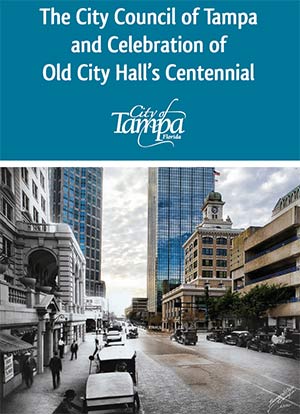
**The City of Tampa has removed
this publication from their
website,
BUT you can still read it and
download it here from TampaPix's
Dropbox folder.
|
|
Over the years,
these two stories,
or some similar
combination of the
two, have made their
way into every
telling of how
Tampa got its City
Hall Clock, who it
was named for, and
why. Its even
part of the Historic
American Buildings
Survey report of
1981 when City Hall
was awarded historic
building status in
1974, along with
other incorrect
historical
information. Some accounts
combine both stories
into one. But
they
just don't fit
together sensibly. |
The image above was created from a Burgert Bros. photo
courtesy of the Tampa Hillsborough Co. Public Library
System.
|
|
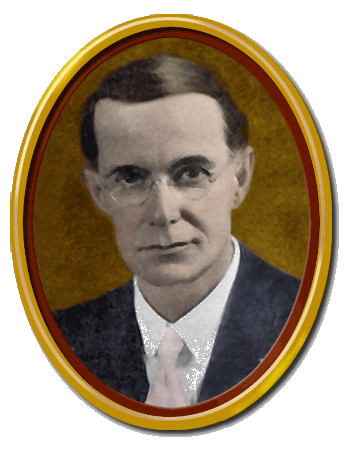
NEITHER STORY
CORRECTLY REFLECTS
WHY, HOW,
OR WHEN IT REALLY
HAPPENED.
As Ernest L. Robinson
appropriately wrote
in his 1928 book,
The History of
Hillsborough County:
The City Hall, finished
in 1915, rises eight
stories, the last five
forming a tower that is
topped by a balcony and
another, smaller tower
containing a clock.
The clock, known
affectionately to city
officials and newspapermen
as "Hortense," has had many
fantastic and
romantic tales
woven about it..."
|
THROUGHOUT THIS
FEATURE, "old City Hall"
will refer to the one built
in 1890, "new City Hall"
will refer to the one built
in 1915.
|
TAMPA'S FIRST TOWN
CLOCK
This courthouse
was built by John H.
Breaker in 1854 at Court
House Square to replace
the 20 ft. x 45 ft.
courthouse built by
James McKay in 1847.
It would be 28 years
later that a tower clock
was installed in the old
Breaker courthouse.
Photo is circa mid to late
1880s,
courtesy of Florida
Memory, State
Library & Archives
of Florida.
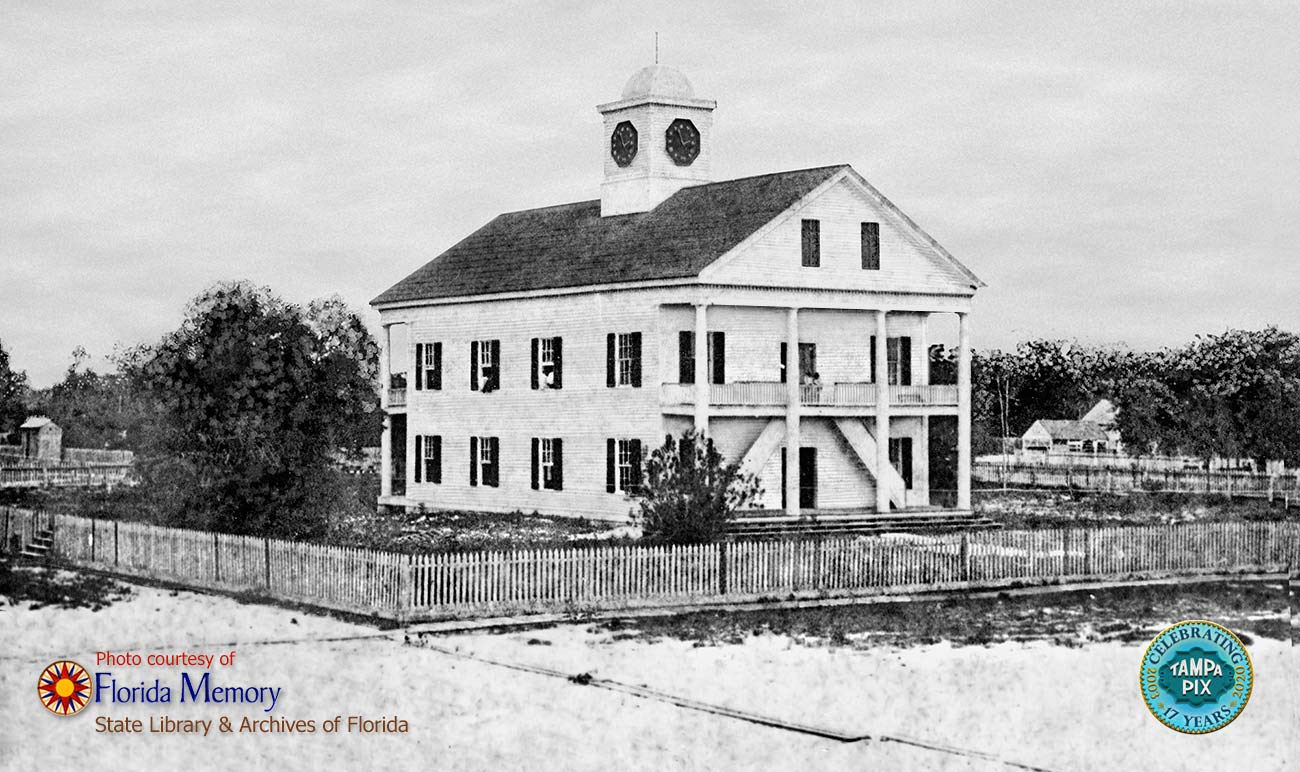
As seen in the 1880s
photo above, the Breaker
courthouse faced south,
with Lafayette St.
running across the front
and Franklin St. on the
west (left), Florida
Ave. on the east side,
and Madison St. behind
it (North.)
HOWEVER, the white sandy
areas seen just outside
the picket fence are NOT
the streets. The
fence enclosed a small
area creating a yard for
the building, but there
was much more property
enclosed by the streets.
The structure has a
four-faced clock in
this photo,
but it wasn't built with
the clock.
An early detailed
description of the
building in 1854
mentions the tower,
but not a clock:
THE TAMPA HERALD
- WEDNESDAY,
JUNE 7, 1854.
Through the
kindness of Mr.
[John H.]
Breaker,
contractor and
builder of this
magnificent
Court House, we
are enabled to
furnish our
readers with a
full description
of its order,
size, various
offices, etc.
etc. The
building is 76
ft. long, by 45
wide, and two
stories high.
...A projecting
Portico, an each
end, the whole
width of the
building
supported by
heavy Grecian
Columns. A
double flight of
stairs ascends
from each end of
the building,
landing on the
2nd floor of the
porticos. The
roof is mounted
with a dome and
tower, 18 ft in
diameter, and 24
ft high, covered
with tin, or
zinc. The
extreme height
of the building,
from the
pinnacle of the
tower to the
ground is 68
feet; and the
whole is being
beautifully
finished in a
combination of
the Grecian,
Ionic, and
Corinthian
orders..."
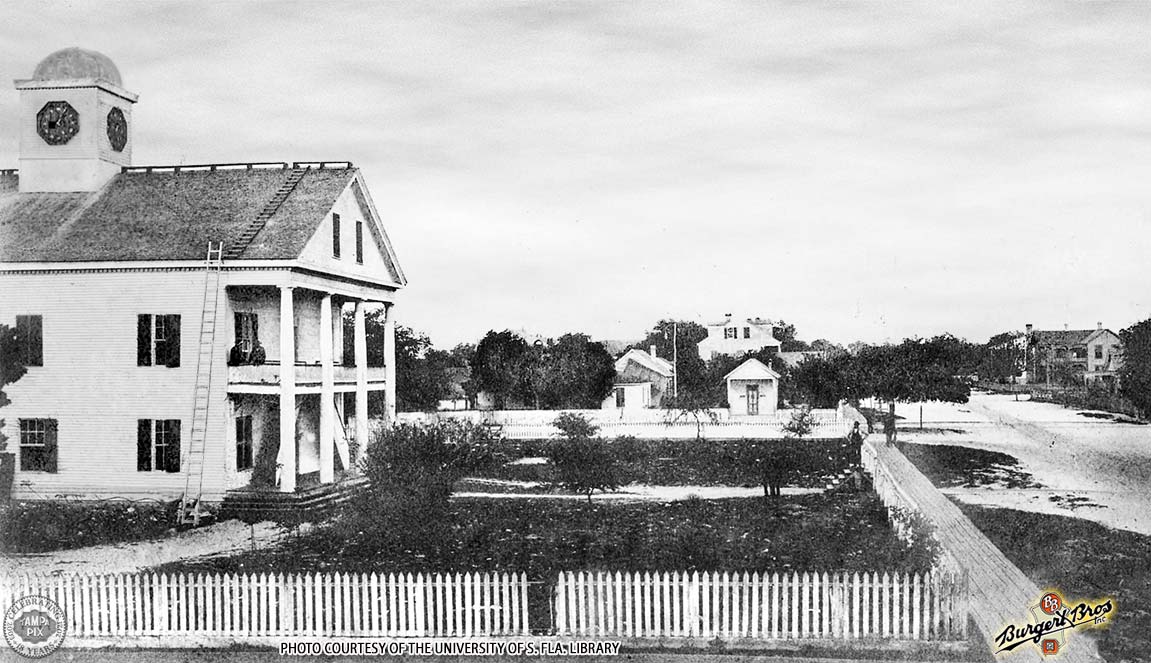
This Burgert Bros.
photo from the USF
Library shows the
courthouse from 1882
to 1892 looking east
along Lafayette St.
towards Fla. Ave.
TOWN CLOCK ADDED
IN 1882
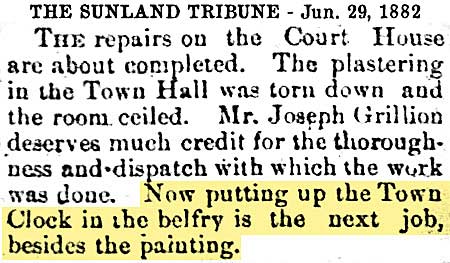
The
clock was added
during a repair and
renovation of the
building in
June/July 1882.
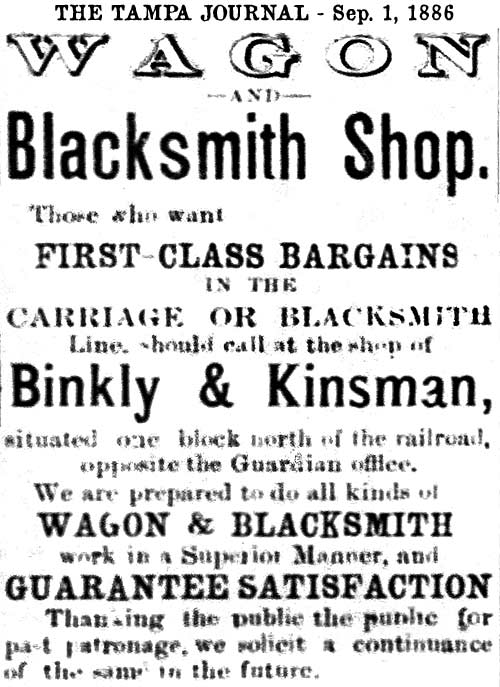

In 1891
this courthouse was sold
and moved to make way
for a new brick county
courthouse.
The
"Town Clock," as
the courthouse clock
was referred to, had
an interesting life
after this
courthouse was sold
to wagon maker J. J.
Kinsman for $345. Today
that would be like
$9,938.
He had the building moved north on
Florida Avenue
across from the
Palmetto Hotel in
1891. But the
clock didn't remain
in this building.
Find out who ordered
the clock, where it
came from, and where
it was used later
(seen at right)
here at
"The
Great Ybor City Fire
of 1908" at
TampaPix.
THE
SECOND LIFE OF THE
BREAKER COURTHOUSE
J. J. Kinsman
remodeled the old
courthouse and
turned it into an
apartment house.
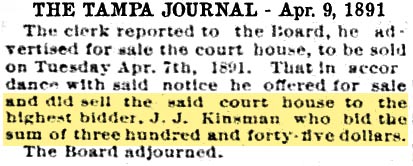 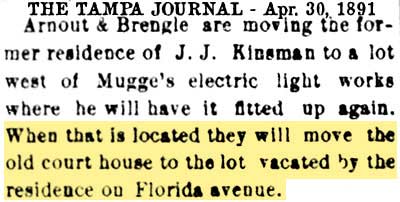 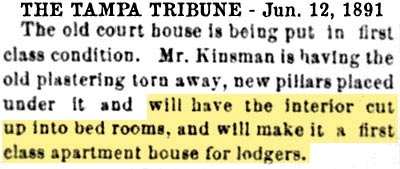
The old courthouse
started a new life
as the Magnolia
House.
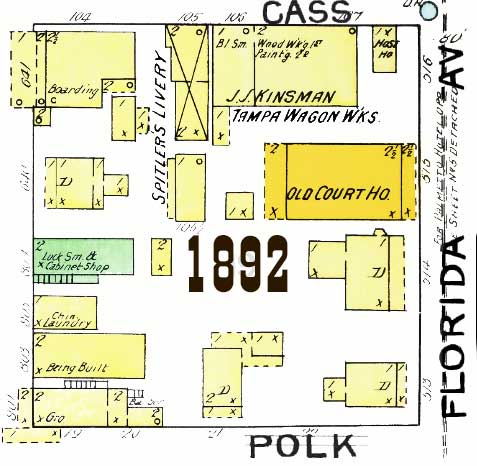 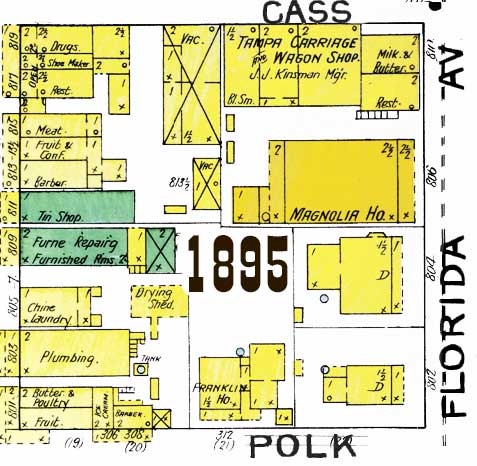
Sanford fire insurance
maps courtesy of the
Univ. of Fla. George
Smathers Library digital
maps collection.
|
By
1899 the
former
courthouse
became the Avenue Hotel
owned by M.J.
Morales and
caught on
fire on Dec.
4. The
fire started
at the
cottage next to it and
spread to the roof of the hotel.
Chief A. J. Harris and five firemen worked
six hoses and doused the fire in a heroic
effort, saving Kinsman's nearby carriage
house and
wagon works. All twenty
hotel guests escaped
unharmed but the top floor was gutted and
the first floor drenched. The article
describes
the building
as three
stories but
they are
counting the
space under
the
roof--the
attic.
The Sanborn
maps show "2
½" stories
which is how
attic space
was
indicated. Evidently
the building was repaired because
in 1903 it appears on the Sanborn maps as the Tampa Sanitarium
(a hospital.) |
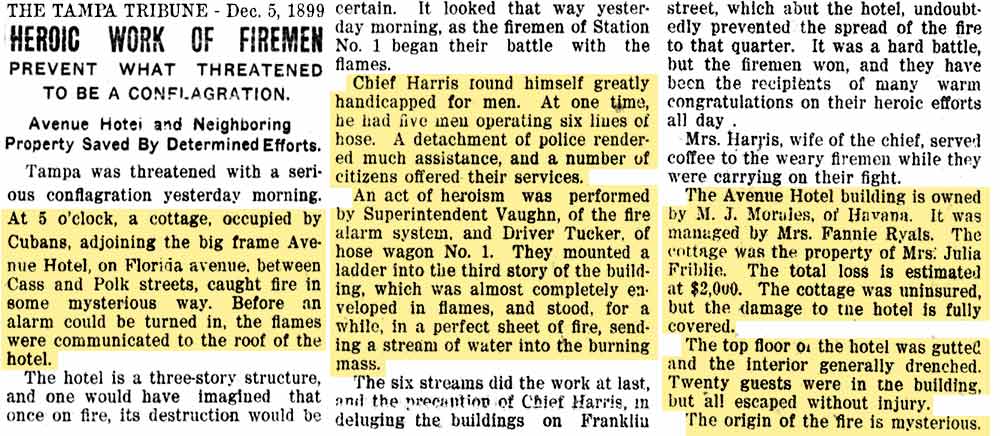 |
|
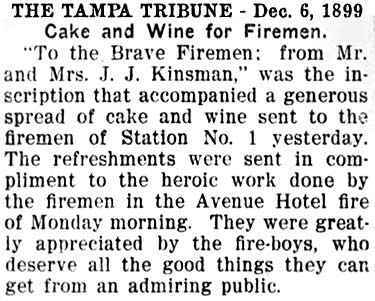 |
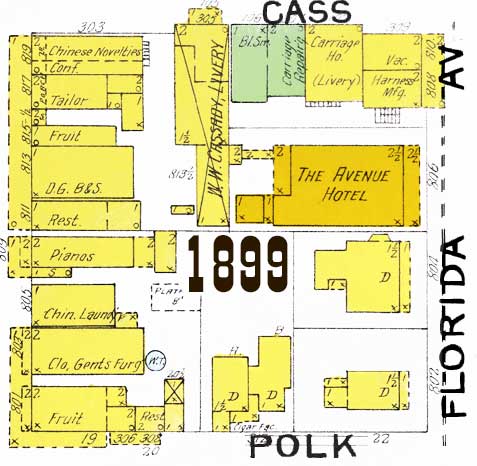 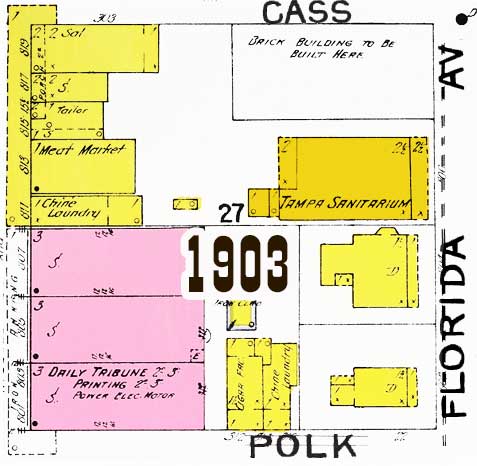
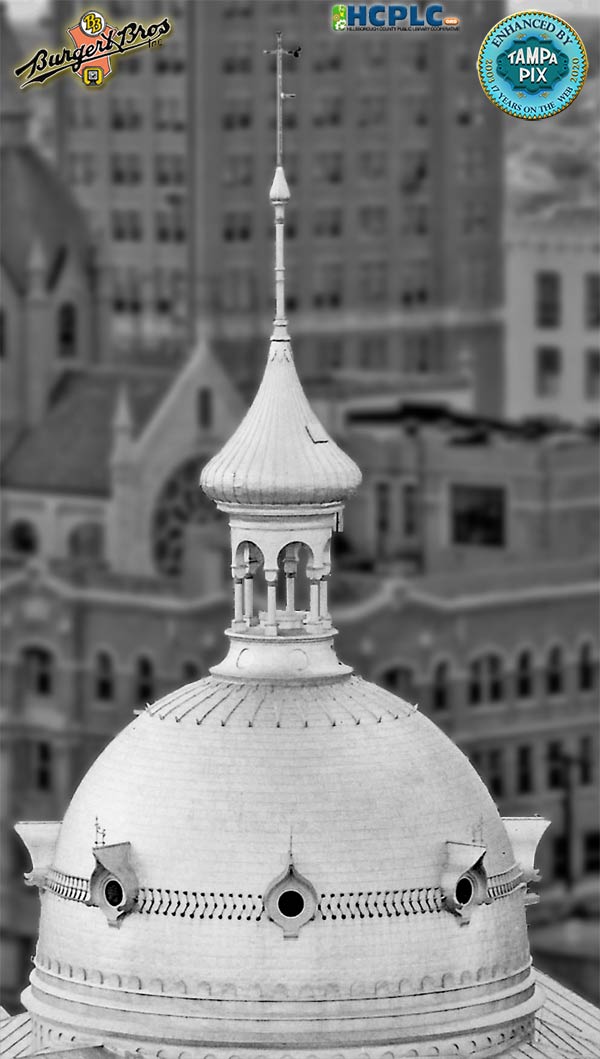
THE NEW CLOCKLESS
COURTHOUSE -1891
When the first brick
Hillsborough County
Courthouse was built at Court House
Square in 1891, it
marked the end of
Tampa's only town
clock. The old
courthouse clock was
probably in storage
until 1893 when it was
installed in a new Ybor
City cigar factory.)
The new
courthouse, designed
by J.A. Wood
(architect of the
Tampa Bay hotel), had a
beautiful onion-dome
topped tower atop a
large, ornate dome,
35 feet in diameter,
in the style he used
for the Tampa Bay
Hotel. This
new building
replaced the old
wood frame 1854 structure
built by John H.
Breaker.
Not
only did this 1891
courthouse not have
a clock, the design
of the dome and the
minaret topper made
it extremely
difficult to fly a flag
from its topper and
maintain it
properly.
Raising and lowering
it was a dangerous
task, even when the
halyard was working
properly. By
Jan. of 1918, the
flag was a dirty,
tattered and torn
old rag, and the
Board of County
Commissioners got an
earful about it from plenty
of Tampans.
It was described as
"...the dilapidated
piece of bunting
floating over the
courthouse dome,
which has been of
late nothing but an
unrecognizable rag.
The winds and storms
and Florida sun have
beat upon it and
whipped and faded
it, until it has
become too
disreputable for
further use."
In mid-January, 1918, a new
7-ft-long flag was
purchased and a
62-ft. tall flagpole
consisting of
galvanized iron pipe
was set solidly in
cement eight feet
deep on the
courthouse lawn. The
flag was to be
raised at sunrise
and lowered at
sunset by "old
Jacobson" the
courthouse janitor.
The earliest photos
of this courthouse
show the weather
vane, but no photo
has been located
showing a flag
flying from the
spire.
Learn more about
this courthouse and
see more photos of
it.

|
THE REAL HISTORY
OF TAMPA'S
CITY HALL CLOCK
"HORTENSE the BEAUTIFUL"
The
civic
improvements
planned
for
Tampa in
the
first
fifteen
years of
the 20th
Century
had a
great
deal to
do with how
Tampa
got its
City
Hall
Clock
and why
it was
named
Hortense.
Looking
only at
those plans
it can
be seen
that
most of the
Hortense
tale we
have
today
couldn't
have
happened or
just didn't
happen. |
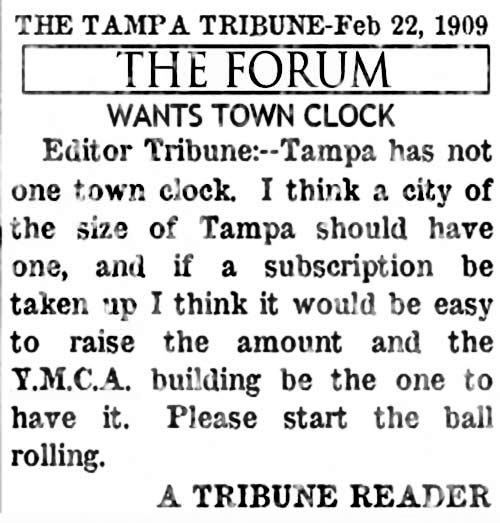
|
|
TAMPA NEEDS A TOWN CLOCK
This Tribune reader
in 1909
thinks Tampa needs a
town clock and
suggests one for the
YMCA building at
Twiggs & Fla.
Avenue. The
reader suggested if donations
were needed it would
be easy to raise the
amount.
He/she ends with,
"Please start the
ball rolling."
Could this be from
Hortense
Oppenheimer?
She would have been
around 20 years old
at the time.
|
|
|
OLD
CITY HALL IS A
DISGRACE
|
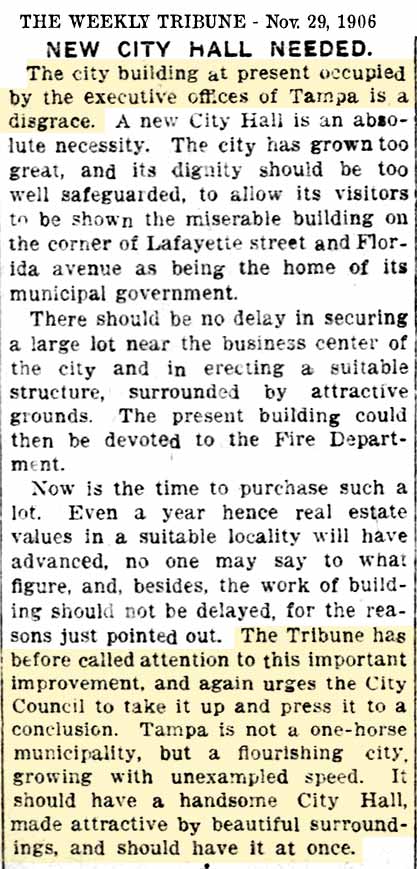 |
|
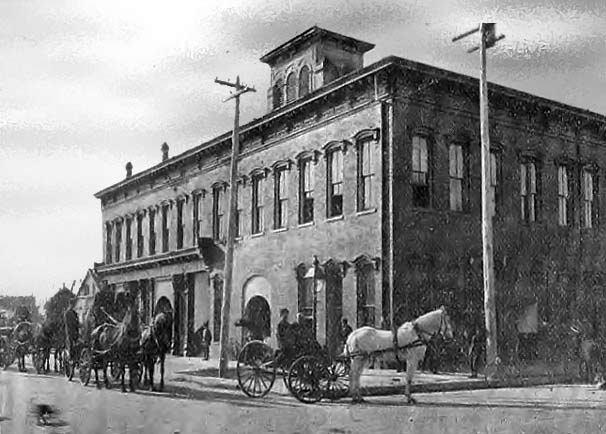
City Hall in Jan.
1900, from a Tampa Tribune
mid-winter edition on Jan. 20, 1900.
As far back as 1900,
it was obvious that
a new City Hall was
needed. The
building was only
ten years old at the
time. By 1911,
Tampa was in
the midst of
a lot of
talk about
needing a
new City
Hall.
This article
below
expresses
the
typical
frustration
and
cynicism that the
people
of Tampa
felt
when it
came to
City
government
coming
to
agreement
on
building
a new
City
Hall.
The
building
that
needed
replacing,
the
first
brick
City
Hall
which
was
built in
1890,
was a
perfect
example
of how
long it
took the
City to
take
action.
Talks of
a new
City
Hall had
dragged
on for
five
years by 1911--five
years of
all talk
and no
steps
taken toward
financing or
building
a new
City
Hall.
|
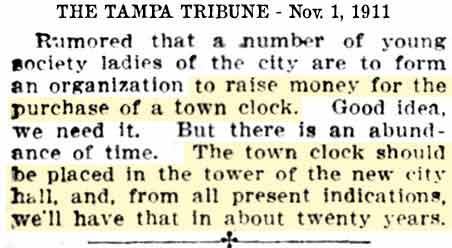
RUMOR OF A
TOWN CLOCK
FUNDRAISER
By Nov. 1,
1911, a
rumor was
circulating
that a group
of young
society
ladies
were going
to organize
to raise
funds for a
town clock.
The writer
says that
the clock
should go into
a new City
Hall, and
the way
things were
going, that
would be
about twenty
years before
one
was built.
|
| |
|
WHO WOULD PUT A
CLOCK HERE?
As you can see from
the photos above and
below,
the City Hall that
was around in in the
first decade
of the 1900s
wasn't
exactly a
scenic spot
for a clock.
This is why
the needed
clock is
referred to
as a "town
clock."
The box-shaped tower on the
roof of City Hall was supposed to house the city's
first electric fire alarm system
and bell.
But even when the interior of
the building was not yet
complete, there was a structural a
problem with the tower.
Fire Chief A.C. Wuerpel
believed the tower
to be too weak to support the new alarm
bell system, warning the Board
of Public Works with his
concerns before he tried
to install the system. Having
been given the complete
authority over installing and
maintaining the new system, he
began to build a separate tower
for it behind the building at
the
southwest
corner.
But the
Chief was
overruled on
the new
tower, the
Board was
more
concerned
with the
new building's
appearance. When
Wuerpel tried
to install the system in the
rooftop
enclosure, a support beam gave way and
broke a part of the system,
which then had to be reordered thus
delaying its installation.
By 1900, the building
was already falling
apart. The
second floor was sagging due to
the massive amount of books and
equipment stored there.
The tower was leaking, adding
to the problem, so around 1905 the
box tower was removed
and the roof
repaired
accordingly.
The
contractor
who was
awarded the
first City
Hall
construction
bid was
James
Bullivant.
During the
interior
construction
phase, Mr.
Bullivant
ran out of
funds due to
seriously
underbidding
the job. When he
realized his
mistake,
he
disappeared;
left town,
and the job
was finished
by another
contractor.
It's
probable
that the
rooftop
structure
was inferior
in design,
material
strength and
workmanship.
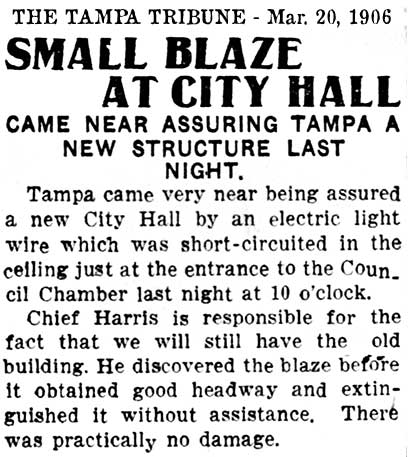
FIRE AT CITY HALL,
March 1906
Thanks to the quick
thinking of Fire
Chief A. J. Harris,
a disaster was
avoided in March
1906. Some
Tampans may have
thought it would
have been a
blessing, as "Tampa came very
near being assured a
new City
Hall...Chief Harris
is responsible for
the fact that we
still have the old
building."
With the fire
department housed in
the building, it
would have been
rather embarrassing
if the blaze had
consumed the place.
In 1911,
City Hall looked as
seen below, more or
less, up until
Feb. 1915 when it
was demolished. This
is the City Hall that was in
existence when the young society
ladies
organized in 1911
to raise
funds for a
town clock. |
Circa
late 1911 Burgert
Bros. photo courtesy
of the
Tampa-Hillsborough
Co. Public Library
System
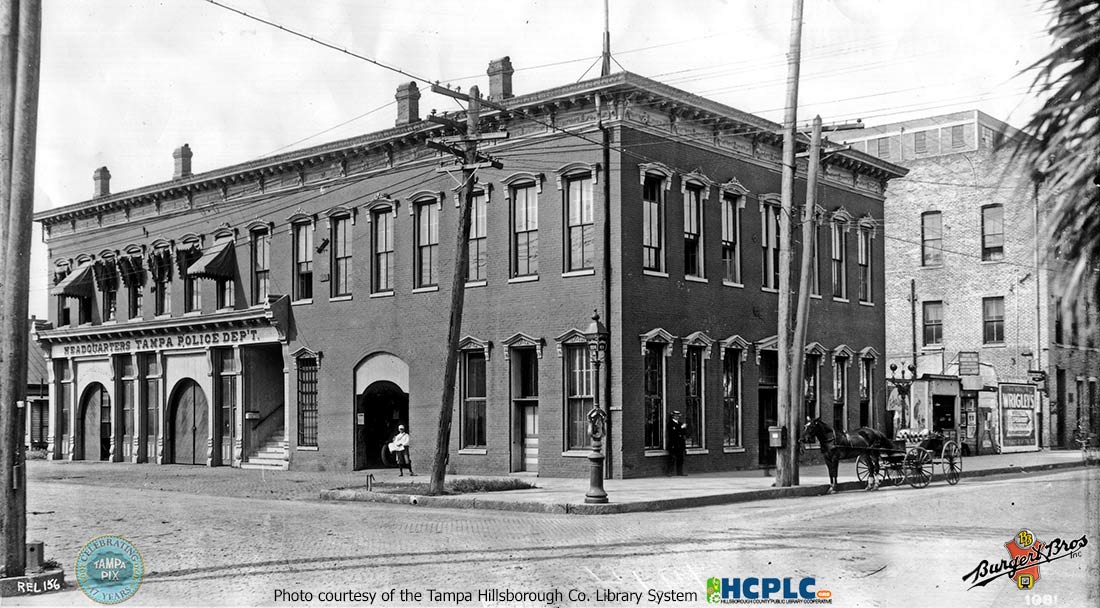
The signage on the
building is an
indication that the
photo was taken
after Oct. 1911. When
the Fire Department
moved out and into
its new building on
Zack Street in late
1911, the
old City Hall
building was then
repaired and
renovated in Oct. of
that year.
The
remodeling
was done to
accommodate almost
entirely the Police
Headquarters.
(These
events are
detailed in
this
feature.) Originally
when built, the
signage showed "Head
Quarters Tampa Fire
Department."
The Burgerts were
commercial
photographers and a
newly completed
repair/ renovation
would have been a
good reason to hire
them to photograph
the building at this
time.
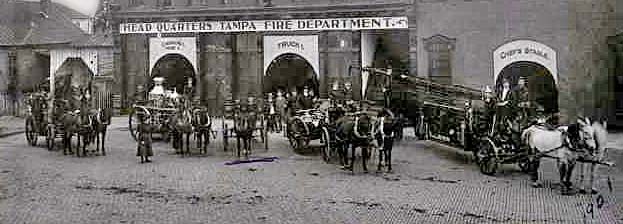
PRELUDE TO A NEW
CITY HALL: THE STATE OF
AFFAIRS IN TAMPA
The rest
of this page
covers the
events of
the various
mayoral
terms as
they related
to the need
of building
a new City
Hall.
The struggle
was on as
early as
1900.
It
establishes
an important
fact that
helps dispel
part of the
long-accepted
"Hortense
story"-- the
harassment
of Tampa's
mayor to
install a
City Hall
clock and
the
availability
of funding.
SKIP to the
next page if
you wish to
skip the
politics.
|
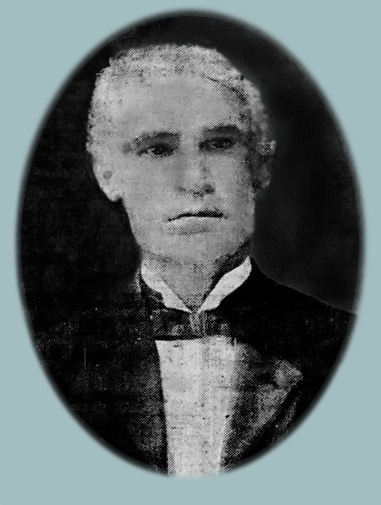
MAYOR WILLIAM HERBERT FRECKER
Term: June 8, 1906 - June 4, 1908
Born May 1852, New Brunswick, Canada
Died Apr. 22, 1914 (age 61)
Photo
is one
of two
used for
his
obituaries.William
married
Canadian
Barbara
Tait in Escuminac,
New
Brunswick.
The
Freckers
had
three
sons in
Canada
before
they
immigrated
to the
U.S. in
1879:
George
T.
Frecker
was born
in 1875,
William
around
1876-77;
and in
October
1878
their
son
Charles
Tupper
Frecker
was
born.
|
See a
history
of the
mayoral
terms of
this
period
as they
related
to other
matters
including
the
Mayors'
personal
lives:
Read
more
about
the
Freckers
in
Canada
and Chicago--William's
involvement
in the
furniture
business,
his
effort
to unite
furniture
merchants
for a
cause;
the "six
o'clock
movement,"
and his
"secret
society"
involvement,
as well
as the
overwhelming
sorrow
his
family
faced
before
coming
to
Tampa.
Also,
learn
about the
circumstances
of his
"Chicago
Furniture
House"
in
Tampa--a
"Mini-Myth"
busted.
Contrary
to some
City of
Tampa
sources
state,
William
did NOT
establish
the
Chicago
Furniture
House or
own it
when he
came to
Tampa.
Read
about how
William
got into
politics,
how he
was
barely
elected
to his
first
position
in the
City
Council,
and why
the
Tribune
calls
him "HOTSTUFF."
A month
after he
became
mayor,
he
became a
grandfather,
and four
months
after
the end
of his
term, he
and his
wife
became
grandparents
of the
first
triplets
born in
Tampa in
many
years.
See a
photo of
them as
young
adults.
Also
read
about
and see
photos
of the
great
Ybor
City
fire of
1908,
an event
which
contributed
to the
defeat
of Mayor
Frecker
in his
1908 bid
for
reelection.
MEET THE
FRECKERS
THE
FRECKERS
IN
CANADA
AND
CHICAGO
WHO
OPENED
AND
OWNED
THE
CHICAGO
FURNITURE
HOUSE IN
TAMPA?
MAYOR
WING vs.
COUNCILMAN
FRECKER
THE
BEGINNING
AND THE
END OF
"HOTSTUFF" FRECKER'S
POLITICAL
CAREER
JUDGE
JOSEPH
BAISDEN
WALL--The
Knot He
Tied and
the Knot
He
Untied
JUDGE
FRANCIS
MARION
ROBLES
THE
EMBEZZLEMENT
TRIAL OF
CHARLIE
FRECKER
MAYOR
JAMES
McKAY,
JR.
MAYOR
FRED
SALOMONSON
THE
DISMISSAL
OF
POPULAR
FIRE
CHIEF A.
J.
HARRIS
THE
GREAT
YBOR
CITY
FIRE OF
1908
THE WING FAMILY IN TAMPA
DEATH OF WILLIAM FRECKER
FRECKER
DESCENDANTS
THE
CANADIAN
FRECKERS |
1906:
WILLIAM
H.
FRECKER,
TAMPA'S
"CITIZENS
LEAGUE"
MAYOR
William
Frecker
served
in the
City
Council
under
Mayor
Frank
Bowyer
from
1898 to
1900.
His
election
to the
City Council
was won
by the
narrowest
of
margins,
after a
vote
recount.
At that
time the
majority
of the
council
were
known as
"The Big
Six" and
the
minority
as "The
Little
Four."
The
minority
was led
by Wm.
Frecker.
Contrary
to some
historical
accounts,
Frecker did
not run for
mayor in
1900 against
Frank L.
Wing.
In 1900 Frecker
ran for
City
Council
again, and
most of
the
candidates
in this
election,
including
mayor-candidate
Wing,
ran
unopposed
as
members
of the
"Citizen's
League." Under
Mayor Wing he
served
in City
Council
from
1900 to
1902.
Frecker
was a
member
of the
Finance
Committee,
the
Schools
and
Public
Buildings
Committee,
and the
Ordinances
and
Rules
Committee.
After Mayor Wing,
the
mayoral
terms of
James
McKay
Jr.
(1902-1904)
and Fred
Salomonson
(1904-1906)
followed. Then in 1906 William H. Frecker
ran for
mayor
for the first time against
Arthur
Cuscaden
and
Frank
Bowyer
and won,
becoming
Tampa’s
Thirty-Sixth
Mayor.
It would be the understatement of the century to say that Wallace Stovall, owner & editor of the Tampa Tribune, despised William Frecker. This was obvious from the start of Frecker's political career as city councilman in 1898. By 1906, Stovall had firmly established his nickname...

|
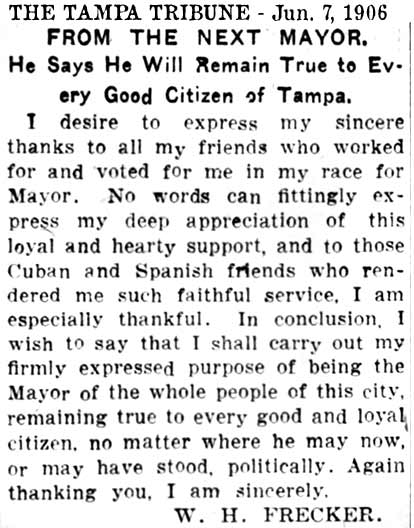
AT
RIGHT:
Mayor Frecker's
brother,
Charles
A.
Frecker,
seems to
have
gotten
the
better
of a man
who made
derogatory
remarks
about
the
Mayor
for
closing
saloons
on
Sunday.
"Bert"
was a
nickname
for his
middle
name,
Albert. |
ENFORCES SUNDAY SALOON CLOSURE LAWOne
of the
first
issues
Mayor
Frecker
addressed
was that
of
saloons
opening
on
Sundays.
A
long-standing
city
ordinance
against
it was
often
overlooked,
with
police
"looking
the
other
way."
|
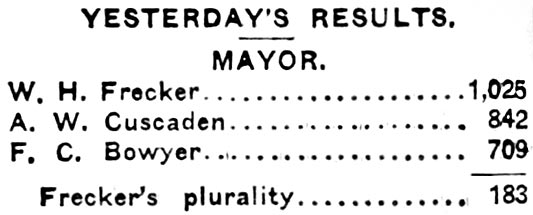
Frecker
also
dealt
sternly
with
officers
exhibiting
immoral
public
behavior,
on or
off
duty. Frecker
suspended
two
officers, Killabrew for
visiting
a saloon
and
drinking
alcohol
on duty,
the
Williams
for
deserting
his
family.
Later in
Aug, a
police
committee
cleared
Williams
and City
Council
dropped
the
charge.
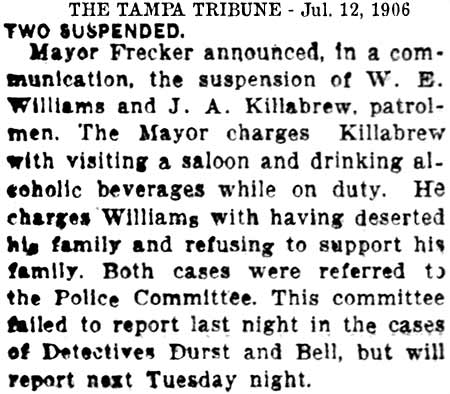
|
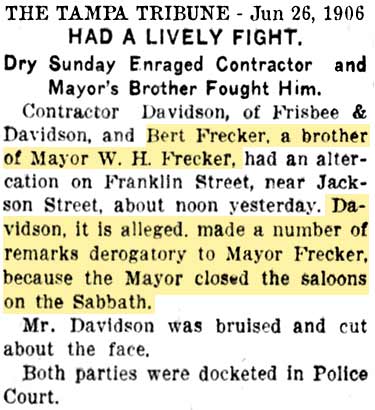 |
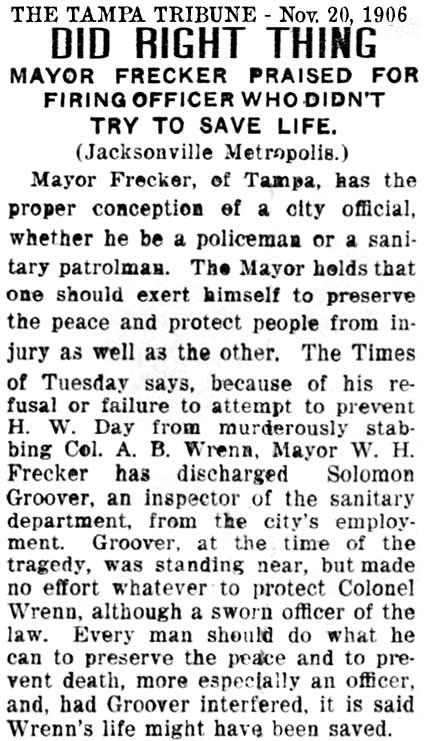
AT
RIGHT: A
Jacksonville
newspaper
praised
Mayor
Frecker
for
firing
an
off-duty
sanitation
inspector
officer
for not
attempting
to
prevent
the
murderous
stabbing
of A. B.
Wrens.
T HIS
IS HOW
WE SAY
"CONGRATULATIONS"
IN
TAMPA
Ex-policeman
J. A.
Killabrew got
revenge
on
Frecker
by
physically assaulting
him in
public.
The
other
policeman,
Williams,
was
informed
by a
lady on
the
street
of the
nearby
fight
and
hurried
there
and led Killabrew
away.
Frecker
asked
that
Killabrew
not be
arrested,
so no
arrest
was
made.

|
|
During his mayoral campaign, Mayor William H. Frecker expressed policies that appealed to both business leaders and the working class. He was quite candid regarding his support for unions yet the business community found in Frecker someone that they could work with. During his term as mayor, Frecker persuaded City Council to "pass ordinances that reduced the rates charged by the Tampa Water Works Company and Peninsular Phone Company."
(Above from City of Tampa website "Past Mayors.") In addition, the City of Tampa annexed the remainder of the Fort Brooke military reservation that was sold, in part, to real estate developers. This was no easy feat, the struggle to incorporate the area dragged out over two decades. See "The Final Battle for Fort Brooke" here at TampaPix.
THE STRUGGLE FOR CIVIC IMPROVEMENT
AT RIGHT:
This Jan 10, 1907 Tribune article is a portion of a longer one in which the Tribune was praising the members of the Lafayette St. bridge committee for their progress. The Tribune then asks if such equally qualified men could have been placed on the City Hall matter. It states that if just the disgrace wasn't enough to get a new one built quickly, the fact that rapidly rising property costs should spur the City into action: "...an ordinary regard for the public purse directs that the land for the structure should be purchased without delay."
In late April 1907, a major step towards a new City Hall was taken when Tampa finally was able to annex the Ft. Brooke area. Mayor Frecker preferred that the annexation and new city charter be passed before trying to appropriate funding for the various wards. It was agreed that a bond ordinance would be needed and a plan made to raise funds by the sale of some city property.
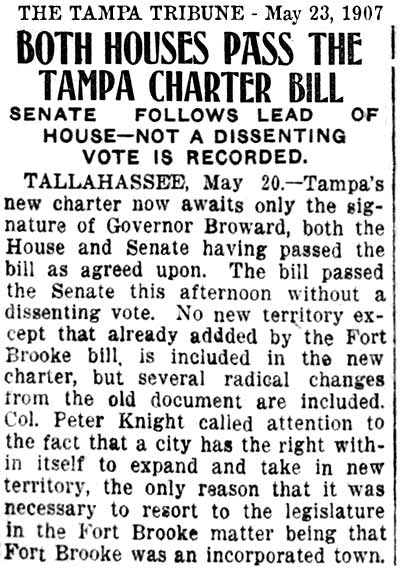
GREATEST STEP YET
After a little over a year in office, Frecker's administration put together a list of proposed costs of the most urgent city improvement issues. The City Hall appropriation was $245,000 which included $45,000 to buy a new City Hall site. The proposed $600k bond issue also included a new bridge across the Hillsborough River at Lafayette Street, (which ultimately would be the concrete bridge we have now,) improvements to the sewer system, and street paving, a hospital and a new jail. The vote was expected to be held on Dec. 10, 1907.
FEW OPPOSE BOND
ISSUE SAYS MAYOR (below)
An
ordinance was passed
to redistrict Tampa
into nine wards, and
as soon as the legal
ads were placed for
it, City Council was
expected to pass the
bond issue
ordinance, then it
would be put up to a
vote.
Mayor Frecker
emphasized that
everyone had to
re-register to vote
due to the
redistricting of the
City and the
adoption of a new
charter.
MAYOR
FRECKER CONFIDENT
BOND ISSUE WILL BE
APPROVED BY VOTERS
Personally, the
Mayor had
heard of nothing but
favorable comments
about the bond
issue, but "in all
progressive
movements, however,
the 'knocker' is
sure to raise his
head. |
The TRIBUNE urges to buy a lot right away before prices go up.
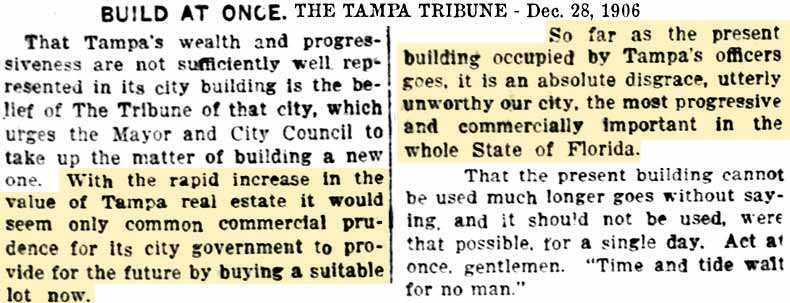 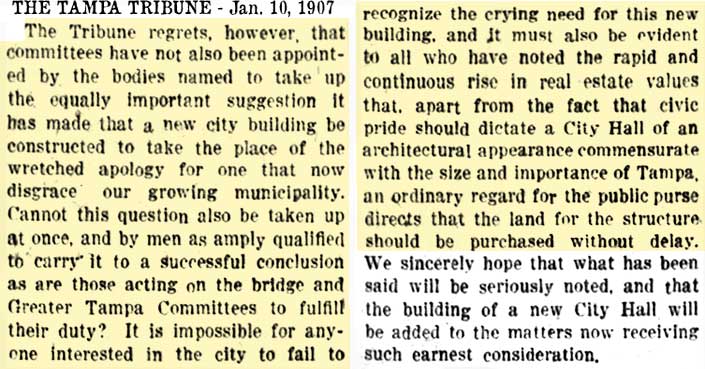
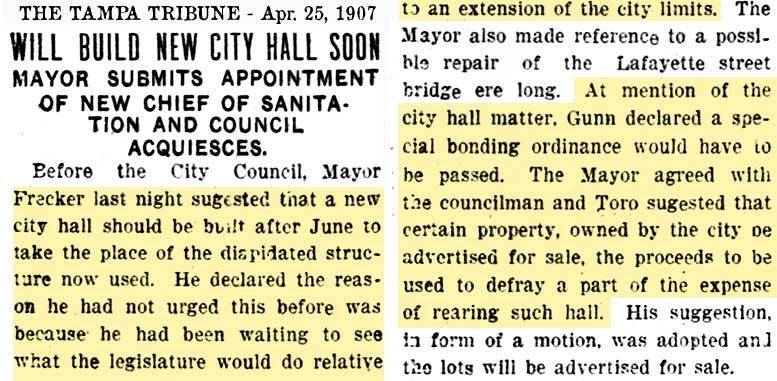
|
|

Every city is
afflicted with
individuals of this
type."
He said that he had
never seen a
commendable movement
initiated that
didn't "raise a warwhoop in
opposition to it.
The people have 'got
on to' this tribe,
however, and their
howls are about as
effective as those
of a dog that
nightly bays to the
moon. Tampa
can't be stopped in
her onward move by
persons of this
class." |
|
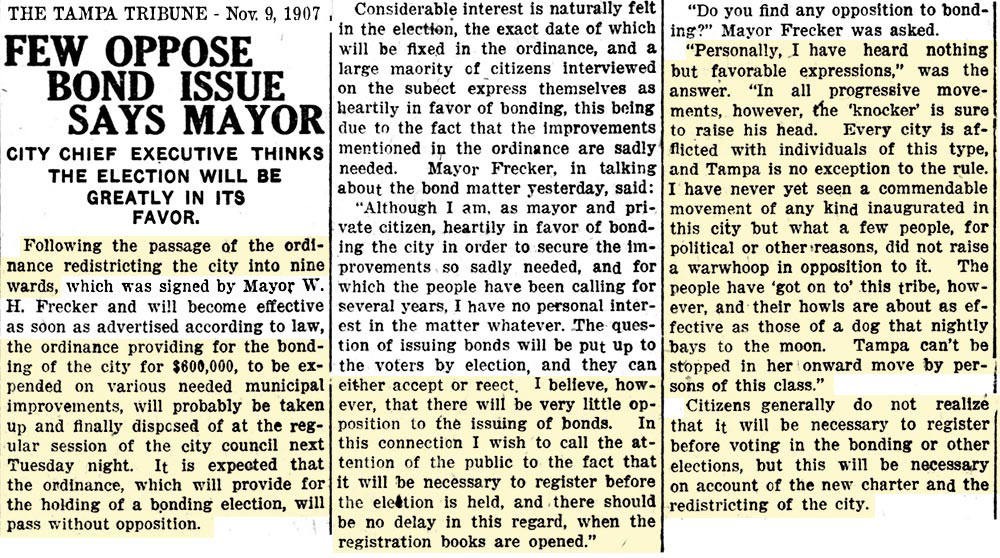
| THE
TRIBUNE URGES NO
DELAY Opponents
to the
bond
issue
argued
that no
institution
would
loan
Tampa
the
funds
and if
they
did, the
City
wouldn't
be able
to
afford
the
interest
rate.
The Tribune said
otherwise. This was one of the few issues in which the Tribune sided with Mayor Frecker. |
DELAY
Fears
caused
by the
depressed
economy
led to
the
postponement
of the
bond
issue.
Mayor
Frecker
said,
"The
bonding
issue
has been
pushed
aside
for the
time
being..."
But
there
would be
no more
chances
for Frecker,
his term
ended in
June
1908. |
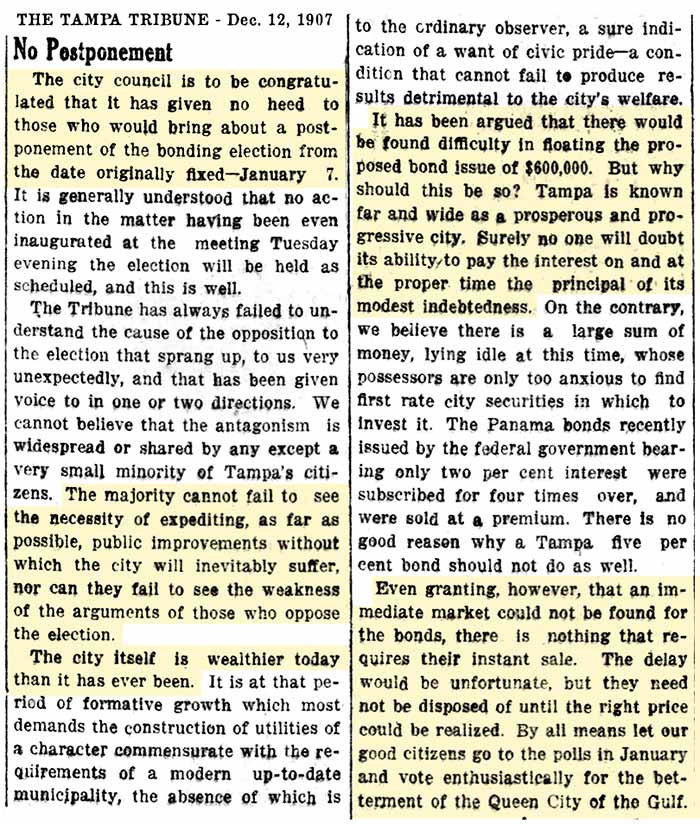 |
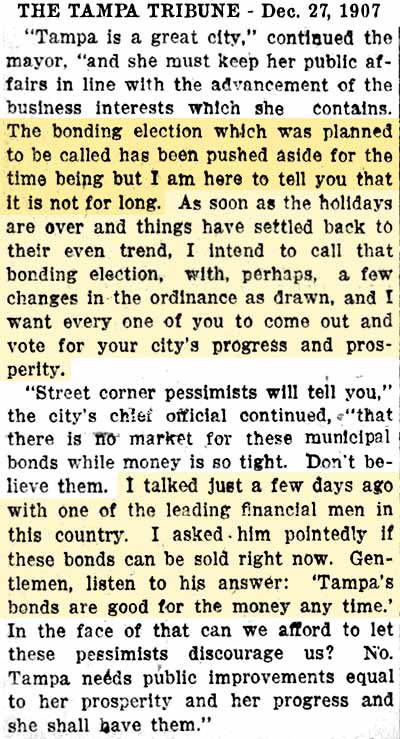
|
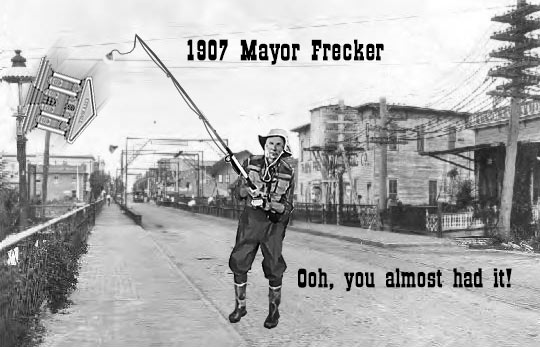
|
FRECKER RUNS FOR MAYOR AGAIN, DEFEATED BY FRANK WING
Wm.
Frecker
campaigned for reelection in 1908 but lost to Francis Wing. More about his
campaign and the election are found on this breakout page, MEET THE FRECKERS.
This was Frank Wing's second time as Mayor, he would serve for two years until Jun. 1910.
By this time, City Hall was in
such a deplorable
condition that
an office in the Giddens building
was rented and
furnished to serve
as Mayor Wing's
office.
| Francis Lyman Wing - Tampa’s 33rd & 37th Mayor |
First Term June 8, 1900 – June 4, 1902
Second Term June 5, 1908 – June 6, 1910
Real Estate Developer, Businessman
Born: May 9, 1868, New Bedford, Massachusetts
Died: October 29, 1941, Tampa, FloridaPhotos at right from City Council of Tampa, 2015 and Mayors of Tampa, 2019 |
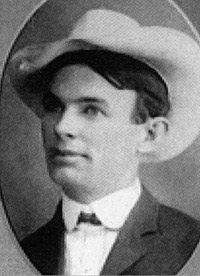 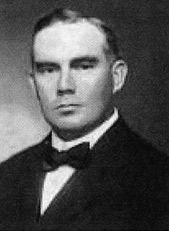
|
|
AT LEFT:
During the term of Mayor Wing, the Tribune continued its assault of William Frecker.
Stovall was critical of Frecker
in much of what he said and did--during his term in City Council, his campaigns,
and his time as Mayor, and here, after his term was over. Apparently, Frecker
and some others attended a City Council meeting and "in his bold and astounding
capture of the meeting" protested against the Florida State Fair and
the proposed
races at the fair, and "by sheer force of nerve and audacity converted
what was intended to be a meeting in the interest of public morals into a
rip-snorting, anti-administration, pro-Frecker political rally."
At right: Frecker
before Judge Cohen
for a bicycle
traffic violation.
The Tribune
thinks he was let
off lightly.
THE HUNT FOR A
DECENT OFFICE FOR
MAYOR WING
June 18, 1908 Tampa
Tribune:
It is now the intention of the committee to select offices in the Giddens building until a new city hall is erected, or at least during the present administration's tenure in office. The office of the mayor will be furnished in keeping with the dignity of the city's executive head...One of the reasons for raising the mayor's salary is that he will have added expenses in his office and it may be necessary to employ a stenographer or secretary.
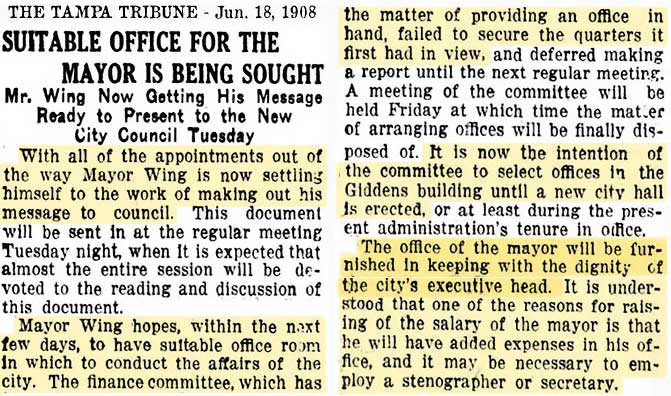
While Mayor Wing was
busy preparing his
first message to
City Council, the
finance committee
was looking for a
suitable office for
him, having failed
to do so with their
first prospect.
Their next choice
was to be the
Giddens building
which was on the
northwest corner of
Lafayette and
Franklin St., across
from the courthouse,
a block away from
City Hall.
BELOW: The
Giddens building on
the corner of
Lafayette
(foreground) and
Franklin St., across
from Court House
Square. Just
up the street can be
seen the Court
Arcade building,
Beckwith Jewelry,
and the towering
Citizens Bank
building.
1912 Burgert Bros.
photo courtesy of
the
Tampa-Hillsborough
Co. Public Library
System.
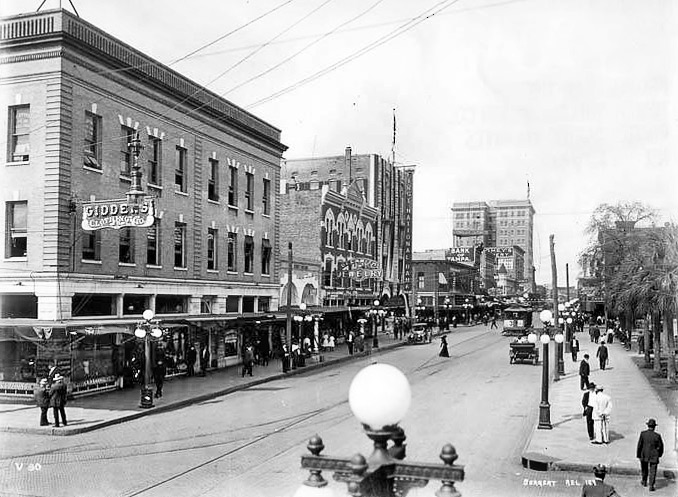
The west side of Franklin St. that faced Court House Square, with Gidden's corner on the north side of Lafayette St.
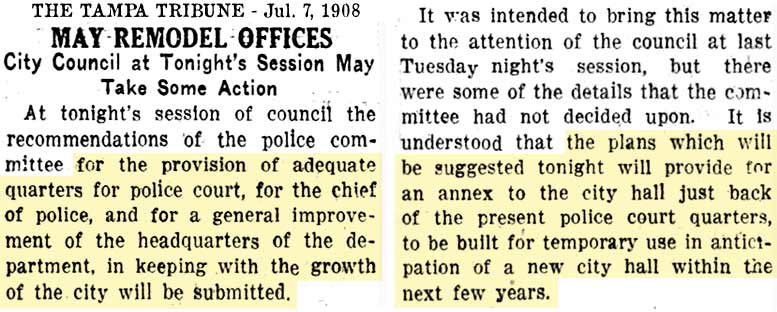
DETERIORATING
POLICE HEADQUARTERS
In early July 1908
the subject of
adequately providing
quarters for the
Chief of Police and the police courtroom,
the
general improvement
of the department's
accommodations came
to the forefront.
The prospect of
building a temporary
annex on the vacant
lot fronting
Lafayette St. behind
City Hall was being
considered.
With the
expectation, of
course, that a new
City Hall would be
built somewhere else in the next
few years.
The issue of
building a new City
Hall was now on its
second mayor.
Part of the urgency
to build a new City
Hall was that they
were considering a
new site and real
estate prices were
climbing rapidly.
But Wing put
emphasis on
improving the water
works system, "a
matter of prime
importance."
In Nov. 1908 Mayor
Wing's
administration was
considering removing
the City Hall bond
issue from the rest
of the improvement
plans because he
thought the City
Hall funding would
cause the whole
improvement bond to
be voted down. The waterworks was of utmost importance, and so a new jail, a new Lafayette St. Bridge, and a new City Hall all played second fiddle. The waterworks company was not in a position to extend its water mains and the City Council felt the only way to supply Tampa's needs was to buy out the waterworks company.


The Tribune warned, should the bond issue pass without a City Hall improvement plan, it could be many years before one could be passed, whether or not the present bond issue without City Hall passed. It goes on to say that now the cost of a new site would be ten times what it was ten years ago, and every year of delay adds thousands of dollars.
"The City Council meets in a barn; the Police Court holds its sessions in a room not fit for the habitation of respectable dogs, the prison cells are a disgrace to civilization, the exterior of the dilapidated old structure is itself a reflection of Tampa and every citizen of Tampa, constituting a standing indictment of official inactivity and civic supineness.
The City is paying out a considerable sum for rental of offices for its officials who cannot find room in its own building. The Mayor finds the city hall too disreputable for his purposes and has offices in an office building. The Board of Public Works has for years occupied rented quarters, even the City Auditor must seek accommodations elsewhere. These office rentals amount to about $100 a month--$1,200 a year paid by the city because it hasn't accommodations for its own officials. This $1,200 would help materially in paying interest on public improvement bonds.
The present building is unsafe; in the course of a few years, it will have to be condemned. Then all the other city officials, including the Council and the Police Department will have to rent quarters. What an inspiring spectacle that will be! The city government scattered all over town in rented quarters. This condition is not three years distant, it is sure to come."
|
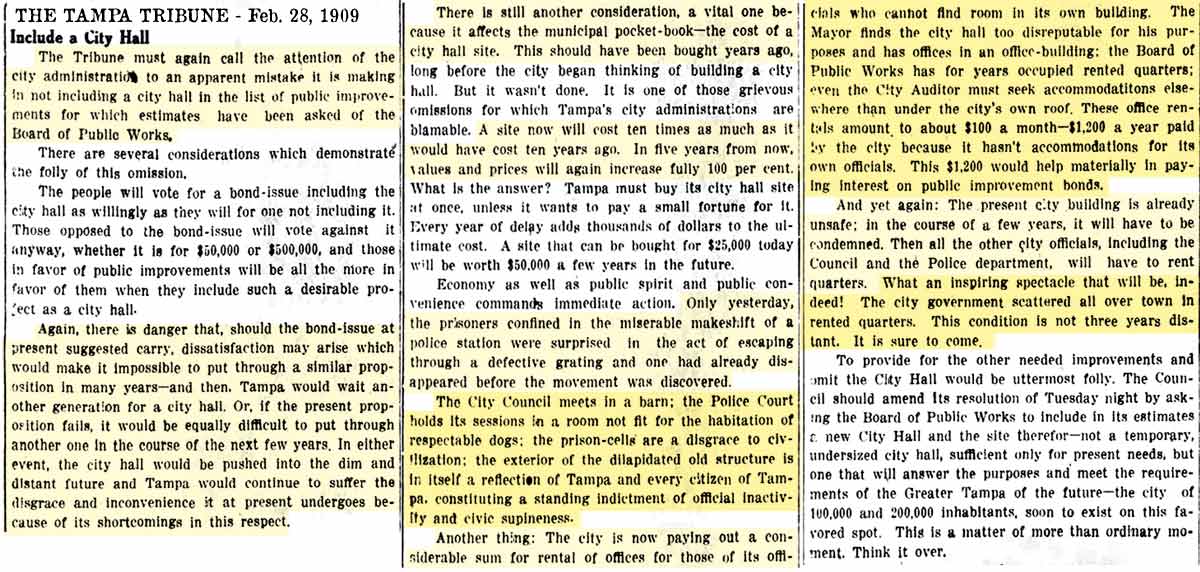
MAYOR WING SEEKS
OPINIONS OF TAMPA'S
BUSINESS LEADERS
|
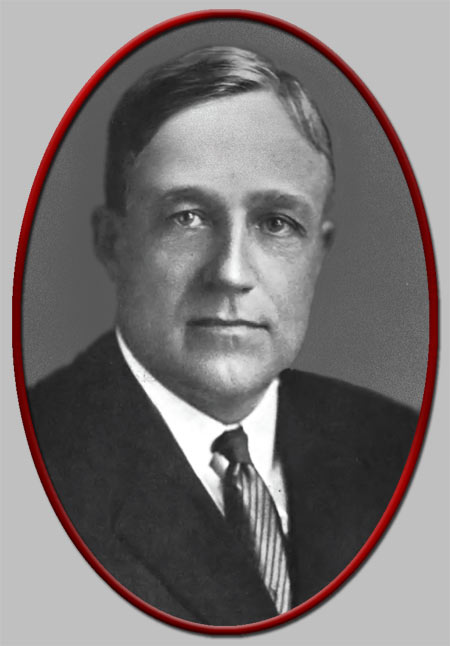
|
On Mar. 24, 1909,
on a suggestion
by Councilman Houlihan,
Mayor Wing met
with representative
leaders of the
community to seek
their opinions on
the
matters at
hand--city
improvements
consisting of a new
hospital, street
paving, sewerage,
and City Hall.
The meeting was
attended by the
Mayor, the editors
of the two local
papers (Wallace F.
Stovall, D. B.
McKay) members of the
Board of Public
Works (Webb, Giddens,
Osborne, Caras), the City Council members (Brown, Gunn, Falk,
Regener, Licata),
and "members of the
various commercial
bodies
of the city" (Pres.
of the Board of
Trade Frank C.
Bowyer, other
members A. C. Clewis,
T. C. Taliaferro),
Pres. of the Tampa
Publicity
club W. B. Gray,
Pres. of the Chamber
of commerce J. L.
Brown , Manager
of Tampa Electric
Co. J. A. Trawick**
"who spoke
interestingly on the
subject
of the bridge,
and Dr. L. W. Weedon of the
Hillsborough Medical
society, who gave
valuable suggestions
concerning hospital
needs.
All readily agreed
that the im- provements were
needed, but opinions
differed as to how
much to spend.
"These divergences
of views were
threshed out
thoroughly and it
was not long before
a consensus was
reached." |
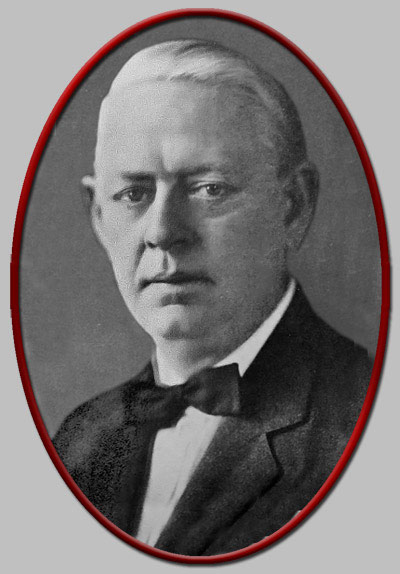
|
|
Wallace Fisher Stovall
Editor, Tampa Tribune, 1924
Photo from "Men of the South" at Hathitrust.org
|
Donald Brenham McKay
Editor, Tampa Times & four-term Mayor of Tampa |
The attendees
reviewed estimates
made by the BPW some
time earlier and it
was decided that a
"five story city
hall, to cost
$75.000 will be in
keeping with the
needs of Tampa at
this time and for
the next few years
to come." They
also agreed on the
site--the footprint
of the present City
Hall. They
thought a building
several stories tall
covering a smaller
area was preferable
to one or two
stories spread out
over more ground.
They wished to save
the expense of
buying property in
doing this.
(The current City
Hall occupied
ONE-HALF of
ONE-QUARTER of the
block, an area 52.5
ft along Lafayette
St. and 105 ft.
along Florida Ave.,
half the length of
the block.)
"Such a City Hall
would be...of the
same dimensions as
the Curry building
on Franklin St., the
tallest structure in
South Florida."
| Tampa City Council members June 5, 1908 – June 6, 1910 Source: The City Council of Tampa, etc. |

|
| W. Lesley Brown, President |
Phillip Licata |
| John Thomas Gunn, President pro tempore |
Herman H. Regener |
| James E. Etzler** (Expelled on 10/9/1908.) |
Ramon Sierra, Jr. |
| Offim Falk (Elected on 10/27/1908. Filled the vacancy of James E. Etzler. |
Thomas B. Smith |
| Charles T. Friend |
Carlos Toro |
| William J. Houlihan |
A. Fred Turner |
**It
was J. A. Trawick,
manager of TECO, who
in 1908 conducted
his own
investigation of
City Councilman
Etzler, whom he
suspected of graft
and corruption. Trawick was fed up
with Etzler's
apparent personal agenda
against TECO in the
City Council
concerning the
contract for power
and lighting for the new
Lafayette St. bridge and other
contracts, so he hired
a private Pinkerton
detective to pose as
a representative of
a large northern
iron bridge company
under alias of "A.
J. North" seeking a
contract for the new
bridge. North
arranged to meet Etzler at the Tampa
Bay Hotel with an
offer that would pay
Etzler to consider
his "company" for a
contract.
Trawick also
arranged for three
prominent
highly-esteemed
Tampa businessmen to
sit at nearby tables
to overhear their
conversation.
Etzler let North
know that "he was the
man who could make
things happen for
the bridge deals" and
that he had complete
control over it.
Then Trawick went to
City Council and the
Mayor with all his
evidence and
witnesses. It
was a long drawn-out
battle ending with
Etzler's conviction
of the charges and
his expulsion from
City Council.
His appeal went all
the way to the
Supreme Court.
This is why the
Tribune reporter
includes after
mention of Trawick,
"who spoke
interestingly on the
subject of the
bridge."
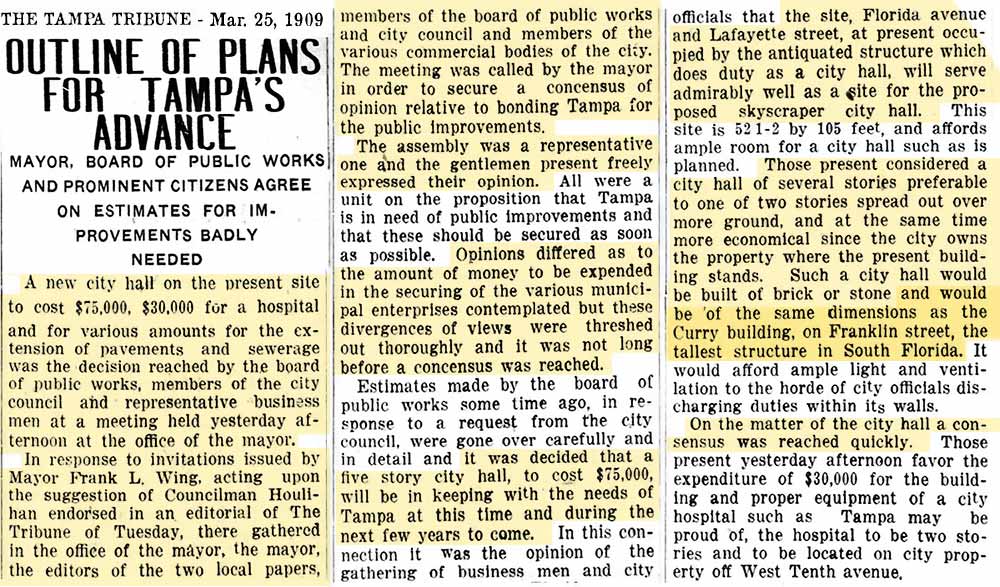
As a result of the
above meeting, the
amount proposed to
build new City Hall
was reduced to
$75,000 with the
passing of Ordinance
No. 501.
Other improvement
issues were divided
among the "old
territory" and the
"newly annexed
territory" (which
was the Ft. Brooke
area.)
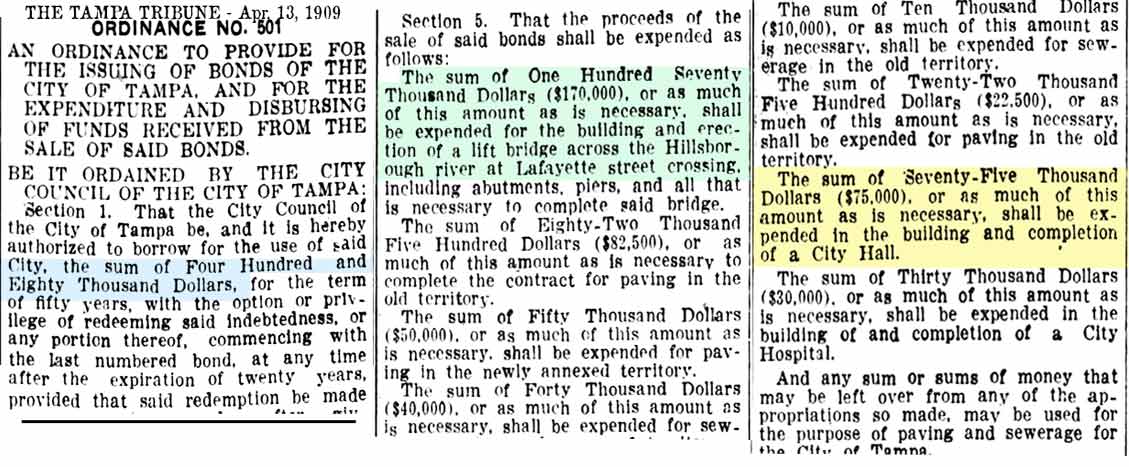
THE TAMPA TRIBUNE
PUSHED HARD IN FAVOR
OF THE BOND ISSUE
On election day,
the Tribune devoted
almost an entire
column to what today
we'd call a series
of "Tweets."
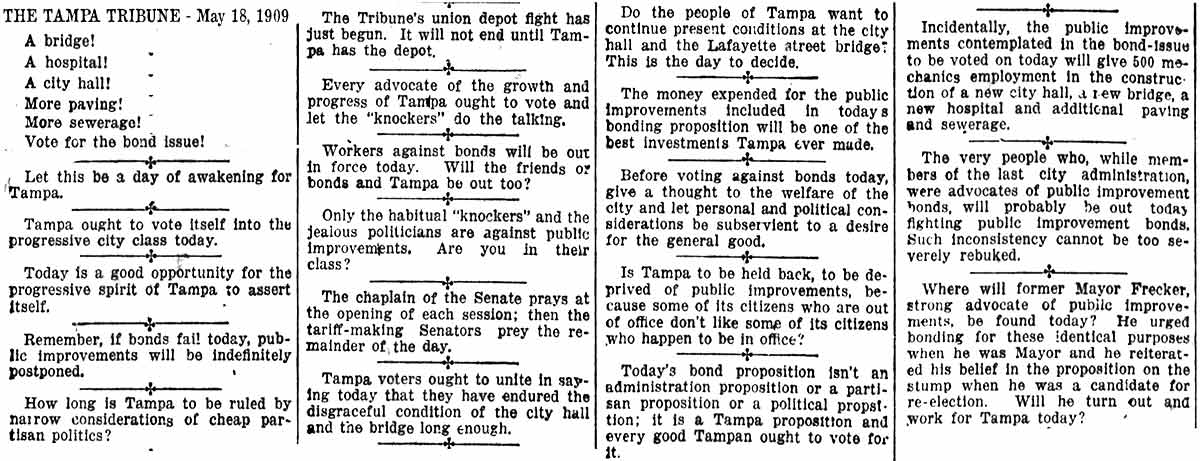
They also published
a long editorial "A
LAST WORD TO THE
VOTERS..."
The article below
has been shortened,
see the whole
article here.
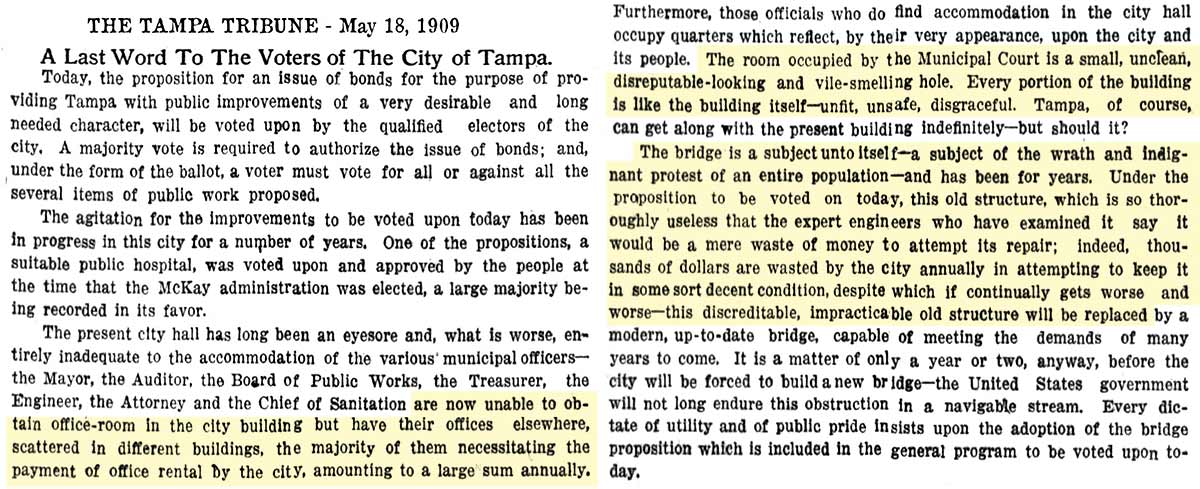
CIVIC IMPROVEMENTS BOND ISSUE VOTED DOWN
On election day May 18, 1909, turnout
was light, with 319 votes for the bonds and 830 against. In no wards were
more people for the bonds than against, even in the Third Ward, which
included Hyde Park. Ward 6, which was Ybor City, opposed it 15 to 1. Tampa voters turned down the municipal bond issue that
would have paid for a new Lafayette Street Bridge, a city hall, a city
hospital, and other public improvements such as sewers and paved streets.Upon post-election reflection, the Tribune theorized that if the bond issue had been split into separate
and smaller specific issues, at least some of it might have passed, although
probably not the bridge issue.
The Tribune gave it's reasons why it thought some voters were
against the bonds. Those are highlighted in various colors below other
than yellow. One reason was that they disliked the city administration, but the main
reason the bond issue was defeated was the bridge itself. Many people thought
that the $170,000 requested for a new bridge at Lafayette Street was just too
expensive. Additionally, people wanted to know how much money the streetcar
companies were willing to contribute and how much of the cost would be borne by
taxpayers, but the answers were not forthcoming. As late as one week before the
election, city councilmen met with the Tampa Electric and the Tampa & Sulphur
Springs Traction companies trying to secure a written commitment. Eventually the
Tampa & Sulphur Springs Traction Company agreed to pay $20,000 for the right to
cross the bridge with its rails and cars; however, Tampa Electric declined to
make an offer.
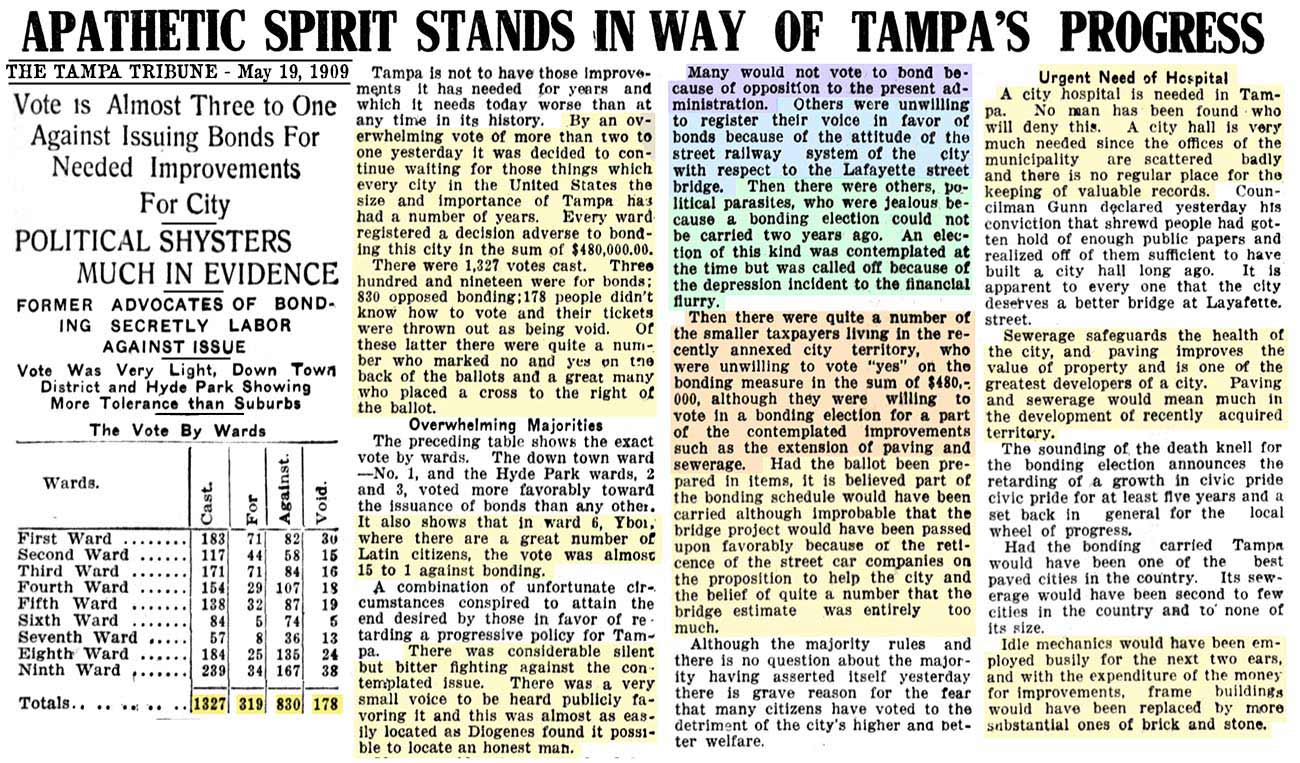
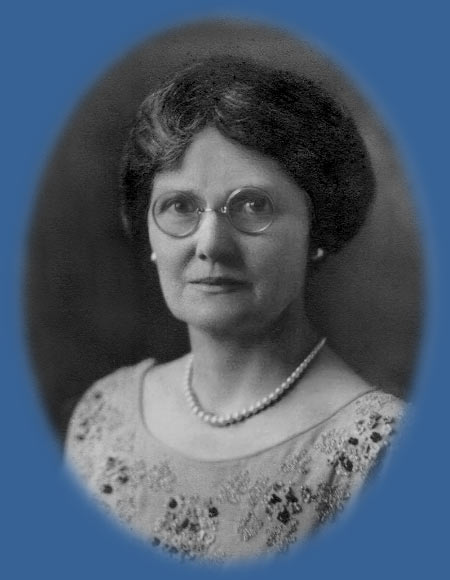 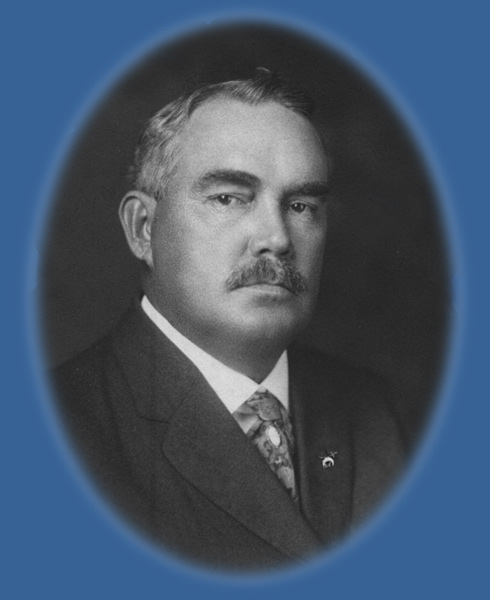 THE WING FAMILY IN TAMPA THE WING FAMILY IN TAMPA
Frank Wing came to Tampa from New Bedford, MA in 1889 at the age of 21.**
In 1892
he
married
Annie E.
Hale,
a resident of Tampa since the age of one (daughter of Horace Harvey Hale & Ida Mary Lipscomb.). An article in the June 10, 1900 Tribune when Wing became mayor says that after his marriage they returned to his New England home with the intention of remaining there. "But thanks to the influence of his wife, he was induced to come back to Tampa."
**His obituary and City of Tampa website say he engaged in the furniture business, but this wasn't until 1900 when he joined Wm. Frecker. READ MORE ABOUT FRANK WING HERE AT TAMPAPIX |
|
| THE MAYORAL CAMPAIGN OF 1910 - TAMPANS READY TO PASS A BOND ISSUE, ACCORDING TO JIM HOLMES
With nine months having passed since the bond issue was voted down, the Tribune published this letter from former City Councilman James. N. Holmes who was a candidate for Mayor in the next election, along with D. B. McKay and Wm. Frecker. Holmes believed Tampans wanted the best, with no corners cut, and that they were ready to vote for a bond issue on civic improvements.
This article has been shortened where the topic becomes other bond issues.
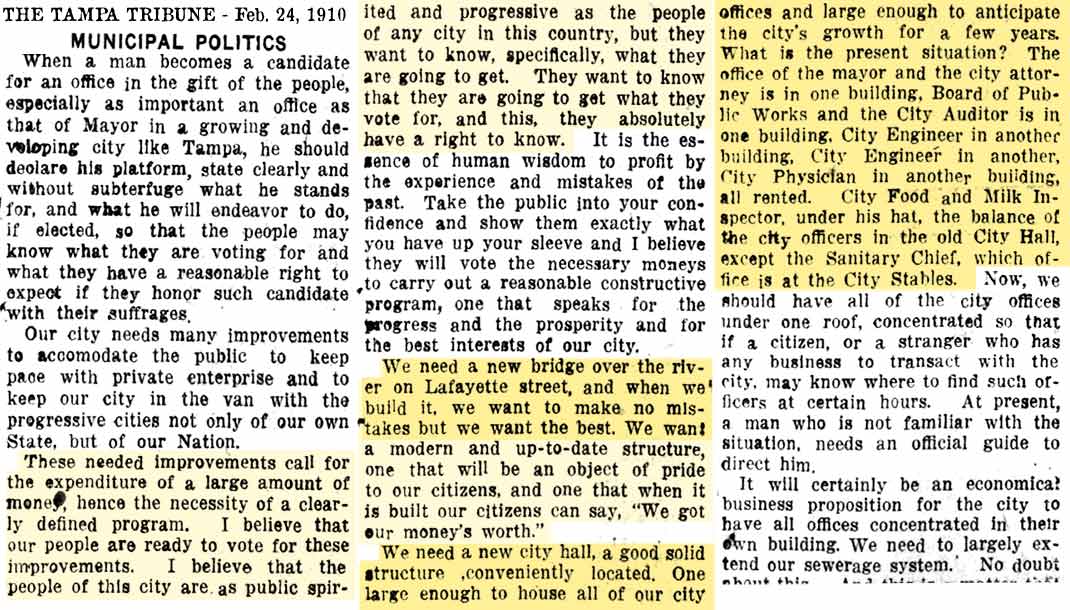
Holmes was ready to debate both McKay and Frecker, face to face, believing it would be "both entertaining and instructing to the voters."
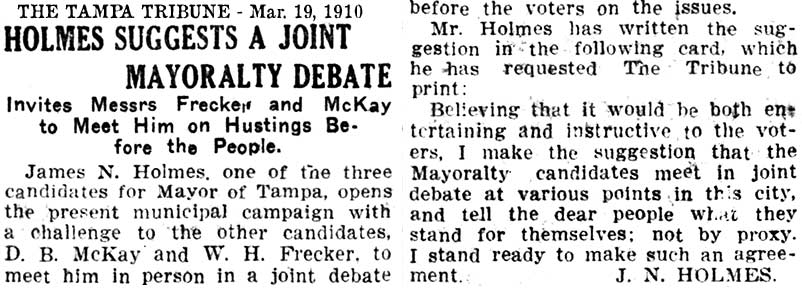 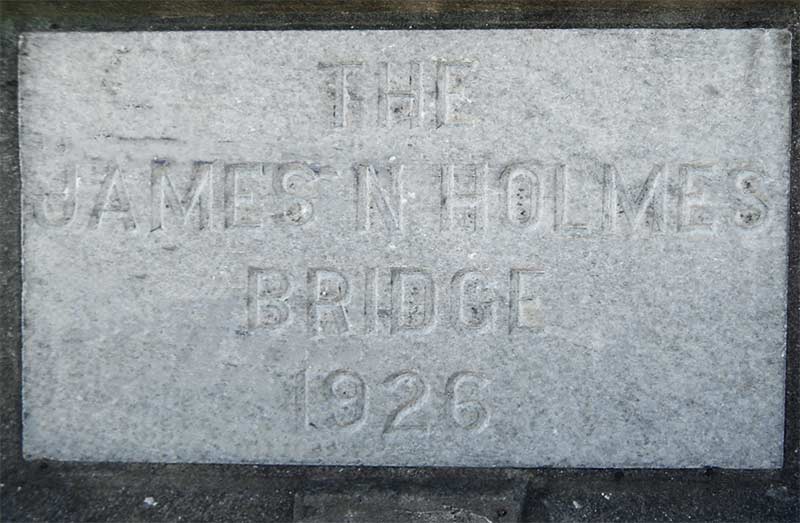
The James N. Holmes Bridge that crosses the Hillsborough River on Florida Ave. in Sulphur Springs is named in his honor.
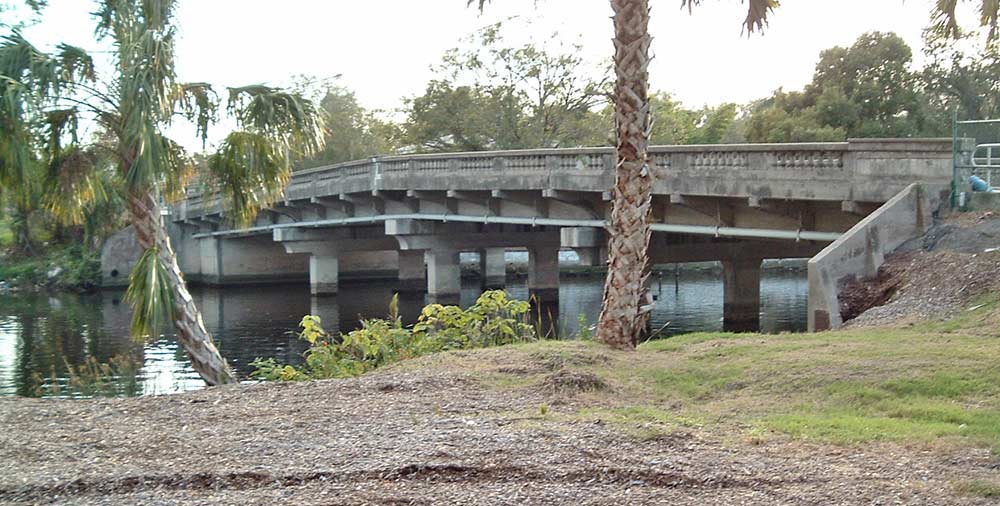
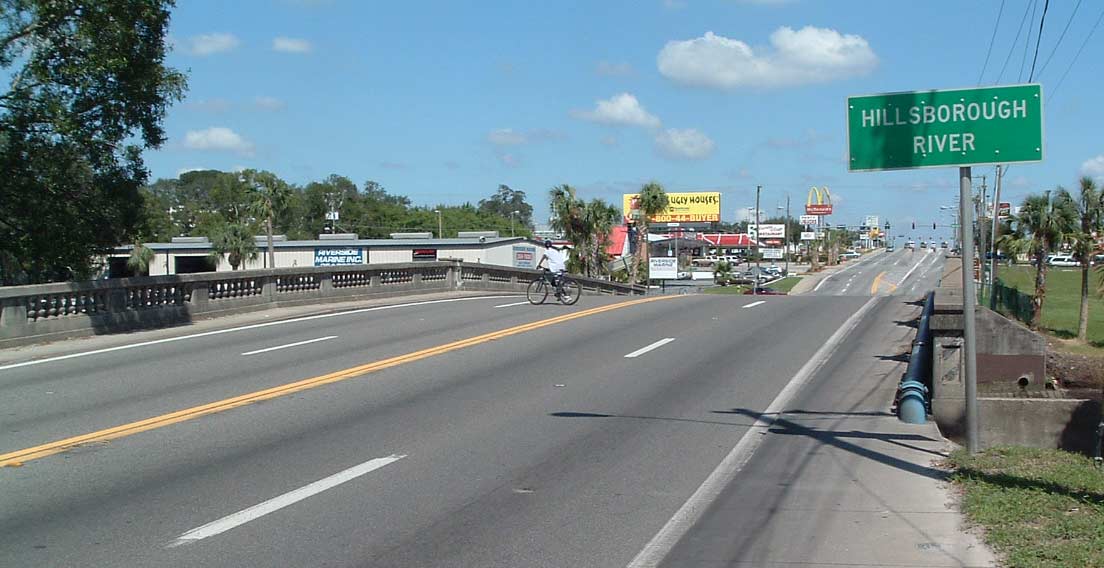
James N. Holmes was a member of Tampa's City Council for three terms, along with fellow council member William H. Beckwith, serving from March 8, 1895 to June 8, 1900, representing the Second Ward, North Tampa. Holmes was a member of the Police Committee as well as the Streets, Alleys and Buildings Committee, and the Cemeteries, Hospitals and Charitable Institutions Committee. He went on to serve on the Hillsborough County Commission as well as on the Board of Public Works. He died on November 10, 1945.
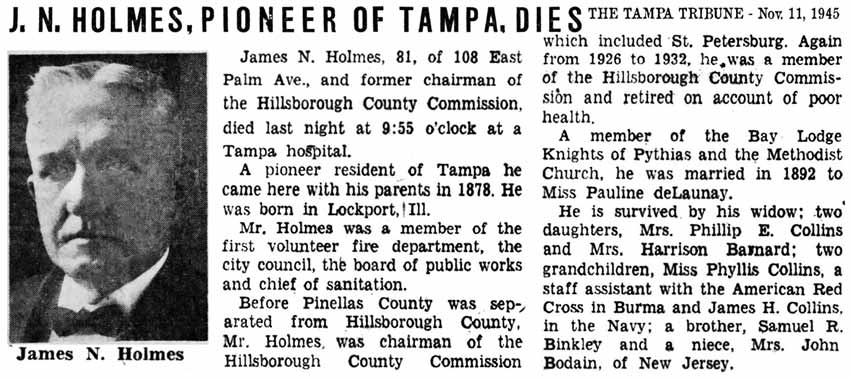
|
|
FRECKER RUNS FOR
MAYOR AGAIN,
DEFEATED BY D. B.
MCKAY
At the end of Wing's
term in 1910 Bill
Frecker ran for
mayor against D. B.
McKay.
Mayoral candidate James N. Holmes was
defeated in the
primary election.
Despite Frecker's
high-profile
endorsements by Hugh
Macfarlane, Edward
R. Gunby and Jim
Holmes, he was
defeated by D. B.
McKay, but only by
136 votes--a less
than 4% margin.
It was the habit of
the Tribune to use
the term "nominated"
to mean "elected."
They also called
every election a
"primary" for some
reason. Here
you see the final
election referred to
as the "second lap"
of the primary
election. We
would call the
"first lap" the
primary and the
"second lap" the
final election.
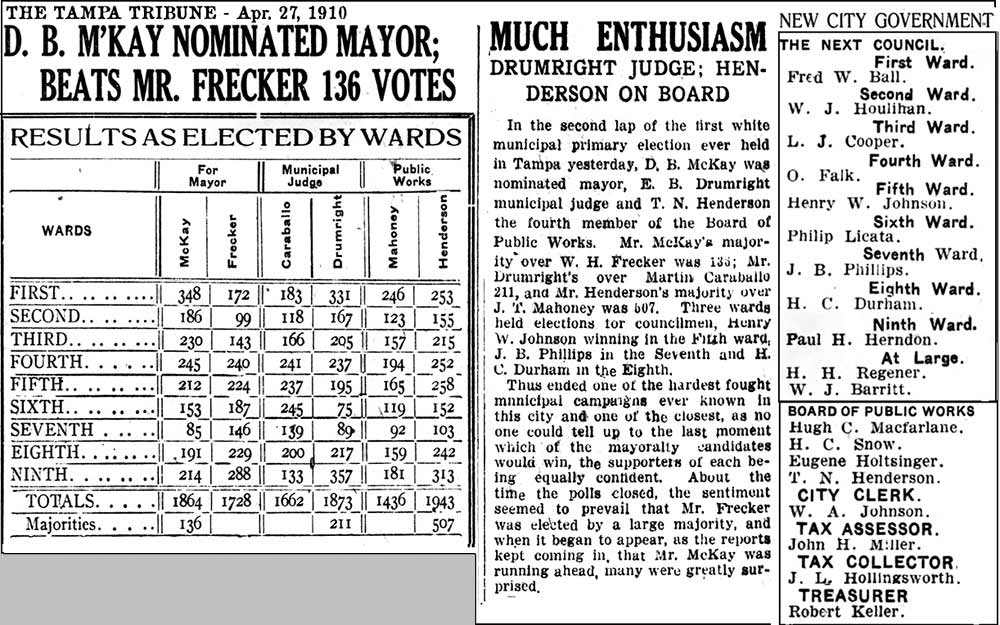
| Donald Brenham McKay - Tampa’s 38th & 42nd Mayor |
1st, 2nd, & 3rd terms:
June 7, 1910 - June
10, 1920
(Elected 1910
for a two-year term;
re-elected in 1912
for four
years, and 1916 for
four years.)
4th term: January 3, 1928 - October 27, 1931
(incomplete
term,
resigned)
Mayor Donald Brenham McKay was one of the giants in Tampa journalism and a legend in his time.
He
was a native Tampan, born in 1868, the son of John Angus McKay and Mary Jane McCarthy, and grandson of
Scotsman Capt. James McKay;
former mayor and pioneer,
merchant , and
cattleman who had
a skill for evading
Navy
blockades during the
Civil War.
McKay was a hard-hitting, outspoken editor who voiced his opinions on the burning issues of the day. He slapped around his rival, The Tampa Tribune, which returned in kind. Simultaneous with being editor and publisher, McKay served a total of nearly 14 years as Tampa Mayor. While he was serving as Mayor, McKay didn't give much time to his paper, in fact in the four (three consecutive) terms ending in 1931 he averaged less than 10 minutes a day around The Times office. |
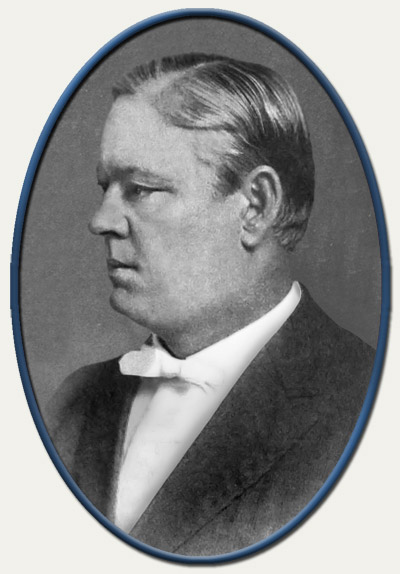 Mayor D.
B. McKay
Photo courtesy of Fla. Memory
State Library & Archives of Fla.
|
| |
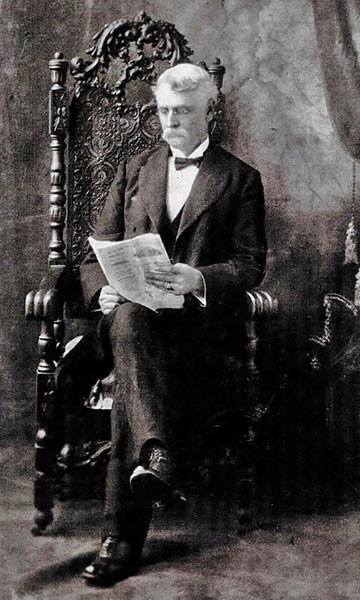 |
BIRTH OF
THE
TAMPA
TIMES
In the early 1890s, both of Tampa's newspapers, the TAMPA JOURNAL and the
TAMPA TRIBUNE (f.k.a. The Sunland Tribune)
were
underfinanced, understaffed,
and limping
along in
a
half-hearted
fashion.
Silas
Armistead
Jones led a
movement
to buy
the two
small
newspapers
and
start a
new
newspaper
that
would be
a credit
to the
city and
a
powerful
factor
in the
development
of the
South
Florida
metropolis
and
surrounding
territory.
He
founded
the
Tampa
Publishing
Company
on
February
1, 1893
with the
financial
backing
of many
leading
citizens.
Jones
became
president;
W. B.
Henderson,
vice-president;
A. J.
Knight,
secretary,
and T.
C.
Taliaferro,
treasurer.
The
company
was
capitalized
for
$25,000.
Immediately
after
the
incorporation,
the new
company
purchased
the TAMPA
JOURNAL
for
$3,500
and the
TAMPA
TRIBUNE
for
$3,450.
H. J.
Cooper
(of the
Journal)
was
appointed
general
manager
at $75 a
month.
D. B.
McKay,
who was
with the
TRIBUNE
at the
time of
the
merger,
was made
City
Editor,
and the
new
newspaper
was
named
THE
TAMPA
TIMES. |
|
S. A. JONES
Silas Armistead Jones, generally known as Col.** S. A. Jones, was born in Shelby County, KY on January 31, 1853. He was a grandfather of Sen. George A. Smathers, who served Florida for several terms, and thus the great-grandfather of Florida Sec. of State Bruce A. Smathers, who served in the Florida Legislature. When he came to Tampa in 1876 he entered the cabinet -making and contracting business. Three years later he started a builder's supply firm. Later he became one of Tampa's most active developers and strongest boosters. He was one of the principal organizers of the Board of Trade in 1885. |
|
SILAS ARMISTEAD JONES
Photo from Tampa Bay Magazine, History: "From Cracker to Flapper, Fifty Boomtown Years: 1875-1925"
By Frank Wells. |
**The title of "Colonel" was a social one, not a military rank. It carried an aristocratic element designating a southern gentleman archetypal of the southern aristocrat. (Contrary to what Tampa Bay Magazine says, he was NOT a Confederate Civil War officer. Jones was 8 to 12 years old during the Civil War and his birth date is accurate.)
|
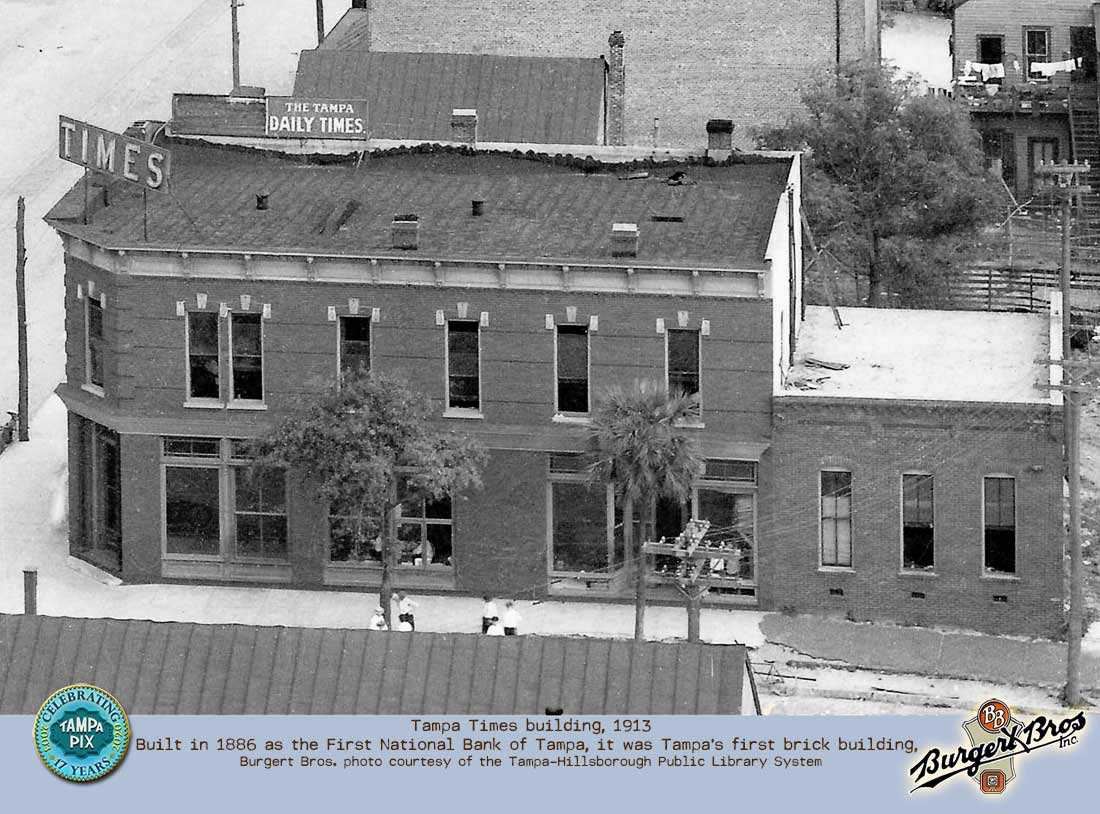
The mechanical plants of the two papers were consolidated in the Journal's plant on the southeast corner of Franklin and Washington, in Tampa's first brick building built in 1885 as the Bank of Tampa. The first issue of the TAMPA TIMES appeared Tuesday, February 7, 1893. 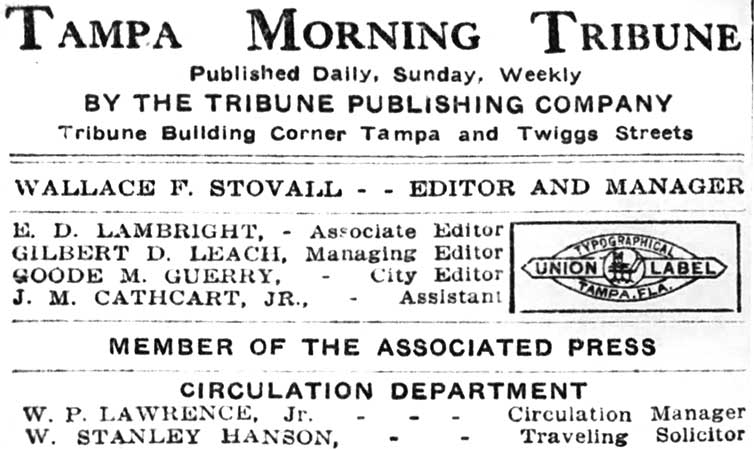 BIRTH
OF A NEW
TAMPA
TRIBUNE BIRTH
OF A NEW
TAMPA
TRIBUNE
Shortly
after
the two
old
papers
were
purchased
and
became
the
TAMPA
TIMES,
word of
the
merger
reached
a young,
aggressive
editor
of a
small
weekly
published
at
Bartow,
the Polk
County
News.
He was
Wallace
Fisher
Stovall,
then 24
years
old.
Reasoning
that the
consolidation
of the
two old
papers
into one
might
provide
an
opening
for an
"opposition"
paper,
Stovall
came to
Tampa
and
found
one man
who had
the same
idea, Dr. John
P. Wall.
With Dr.
Wall's
endorsement
on a
note,
Stovall
borrowed
$450 to
move his
plant to
Tampa
and
start
publishing.
The
first
issue of
his
paper
appeared
March
23,
1893. He
called
it the
TAMPA
TRIBUNE,
using
the name
of one
of the
papers
which
had
perished.
The new
Tribune
then
began
waging
war
against
the
Times
with
sharp
criticism
for
everyone
involved,
especially
for
Jones.
Image
from
1909. 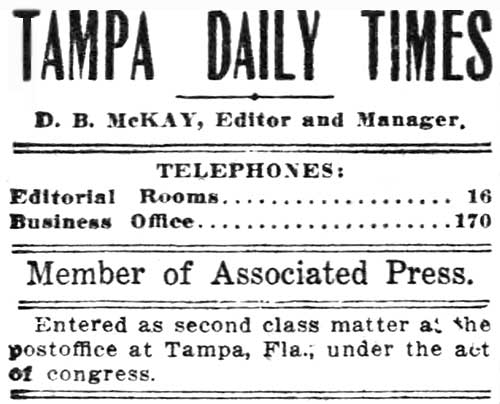
MCKAY
BUYS THE
TAMPA
TIMES
In the latter part of 1898, at end of the Spanish-American War, The TAMPA TIMES was in financial trouble. H. J. Cooper called D. B. McKay into his office. There wasn’t enough money in the till to pay for an incoming shipment of newsprint. Cooper had been offered a job in Cuba and McKay could have the management contract for the amount of Cooper’s moving expenses to Havana. McKay walked over to the Court House where he borrowed the needed $500 from former Gov. Henry L. Mitchell, who was then serving as Clerk of Circuit Court. Within a year, The Times was on a sound basis and was speedily buying out the local businessmen who had stock in it. It took McKay until 1922 to buy up the last stock and become the sole owner. Image at right from 1912
McKay owned The Times until 1933 when he gave a lease-option to David E. Smiley and Ralph Nicholson, who acquired ownership in 1938. McKay then wrote a popular column called Pioneer Florida, which was published in the Tampa Tribune, from approximately 1946 until 1960.
Those
articles
have
since
been
published
in a
book,
"Pioneer
Florida"
consisting
of three
volumes.
Same building in
the
1950s
Courtesy
of the
USF
Library
Digital
collection
of
Sunland
Tribunes
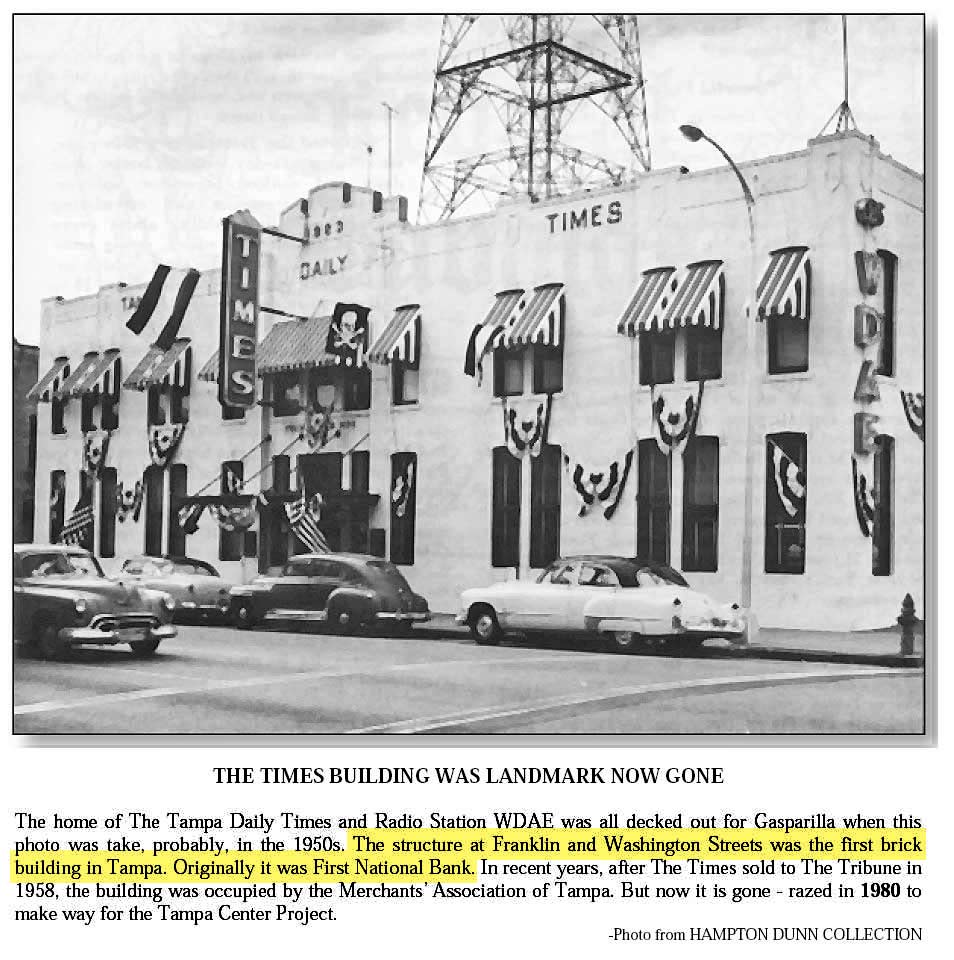
*There
are no
scanned
images
of the
Tampa
Times
online
until
1912,
and
those
beginning
in 1912
are in
very bad
condition.
It
appears
that
they
were
probably
kept in
an
unprotected
environment. For a
history
of
Tampa's
newspapers
from
Pre-Civil
War
times
and the
life of
Silas
Jones,
see
A
History
of
Tampa's
Newspapers
here at
TampaPix.
Information combined from:
-
Biographies section & p.199, 200 of "A History of Tampa" by Karl Grismer
-
THE SUNLAND TRIBUNE, Journal of the TAMPA HISTORICAL SOCIETY, Volume VI Number 1 November, 1980 - THOSE HELL-RAISIN’ TAMPA NEWSPAPERS By Hampton Dunn
-
History of Hillsborough County, Florida, Narrative and Biographical, 1928, by Ernest L. Robinson, Director of High Schools of Hillsborough County, Formerly Principal of Hillsborough County High School.
-
Mayors of Tampa, 2019
|
|
PLANS FOR A NEW FIRE
DEPARTMENT HEADQUARTERS
UNDERWAY It takes an
exceptional breed to
be a firefighter,
especially in
those days.
The risk of injury
or death was high,
not just fighting a
fire but getting to
the location of the
fire. The poor
conditions of the
streets, if streets
existed at all, and
unpredictable horses
pulling equipment at
top speeds, all led
to firefighters
being thrown into
the street,
sometimes with
fatal results.
This exceptional
photo shows Tampa's
bravest posing in
front of the old
City Hall fire
headquarters circa
1890s. This
photo appears
courtesy of Bill
Townsend's "Tampa's
Bravest" website.
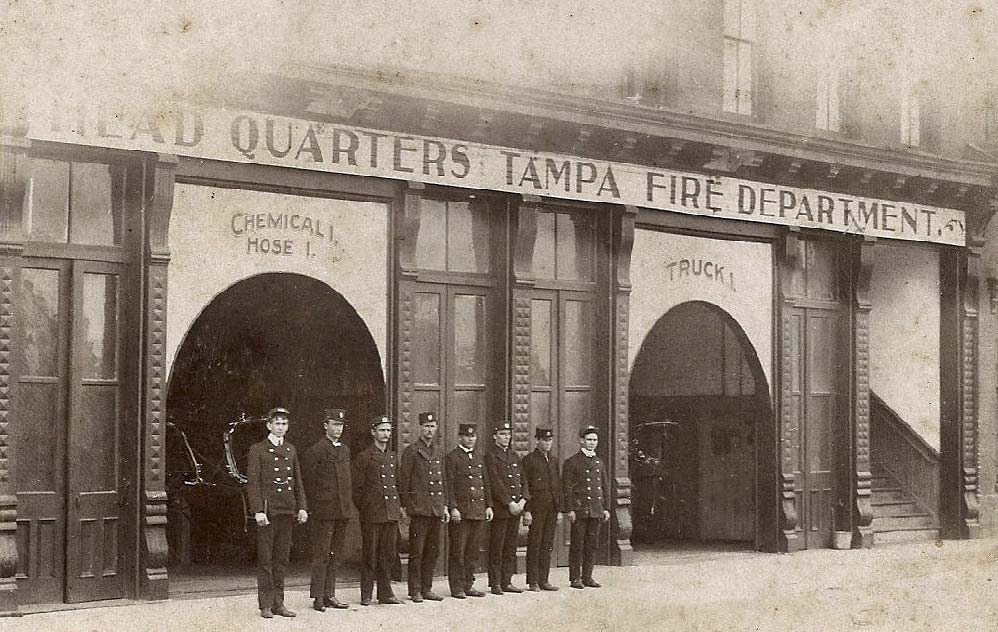
| ARTICLE
BELOW:
After
about
four
months
into D.
B.
McKay's
first
term,
plans
were
progressing
to build
a new
Fire
Department
headquarters
at Zack
and
Jefferson
streets.
Architect
Fred
Curtis
had the
plans
nearly
completed
for the
property
recently
purchased
by the
City
from
Adam
Katz of
Ybor
City |
THE FIRE
HEADQUARTERS
AT OLD
CITY
HALL
The
photo
below is
dated
1901* and the
original
tower
is still
on the
rooftop.
It was
originally
intended
to house
the
alarm
system,
but was
too weak
to
support
it.
A
separate
tower
had to
be built
for the
system
instead,
which
can be
seen at
the left
rear
corner
of the
building.
Displayed
on the
street
are the
truck,
wagons, pumper
and
horses
stored
in the
old City
Hall
building.
At far
left can
be seen
the old
Sheldon
Stringer
house.
|
The new
brick
headquarters
would be
two
stories
with
concrete
floor,
measuring
100 feet
along
Zack St.
and 69
feet
along
Jefferson,
with
entrances
at both
streets.
The
ground
floor
would be
used for
offices,
one for
Fire
Chief
Mathews
and one
for
public
business.
Also on
the
ground
floor
was
storage
for hose
racks,
horse
wagons,
automobiles,
and
stalls.
The
second
floor
would
house
dorms
for the
firemen
and
lavatories,
as well
as three
rooms
for the
Chief,
Asst.
Chief
and the
Captain
in
charge
of
Station
1.
Racks
for
drying
the
firemen's
clothing
would be
located
on the
gravel
roof,
but out
of view
the
general
public.
The new
headquarters
would
result
in more
room at
City
Hall for
other
branches
of City
government |
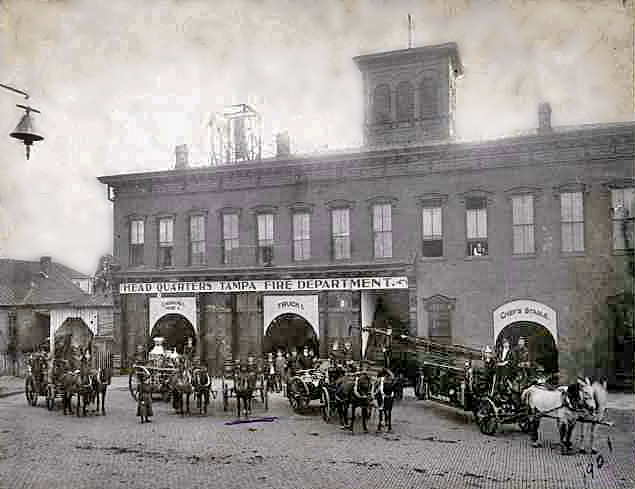
Photo
courtesy
of Capt.
Bill
Townsend's
Tampa's
Bravest
website.
*If the 2nd vehicle from the left is the steam powered Nott pump truck "Elmore Webb" this photo is from no sooner than March 1905.
The former home of Dr. Sheldon Stringer can be seen at far left edge.
|
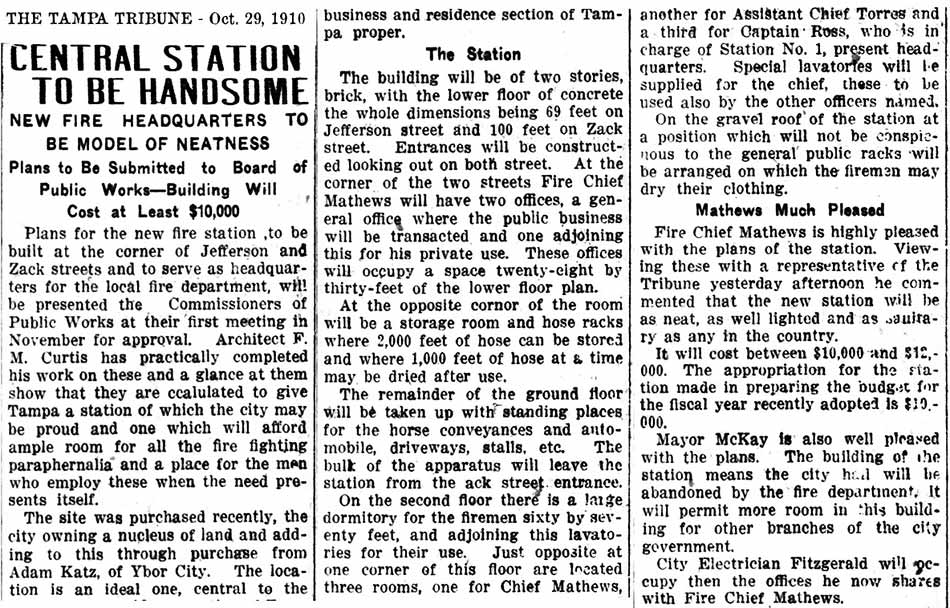
|
BELOW:
In early
Feb.
1911,
plans
for a
new fire
department
headquarters
would be underway
when the
final
design
by Fred
Curtis
was
approved.
The new
station
would be
at
Jefferson
St. and
Zack and
take up
half the
block. |
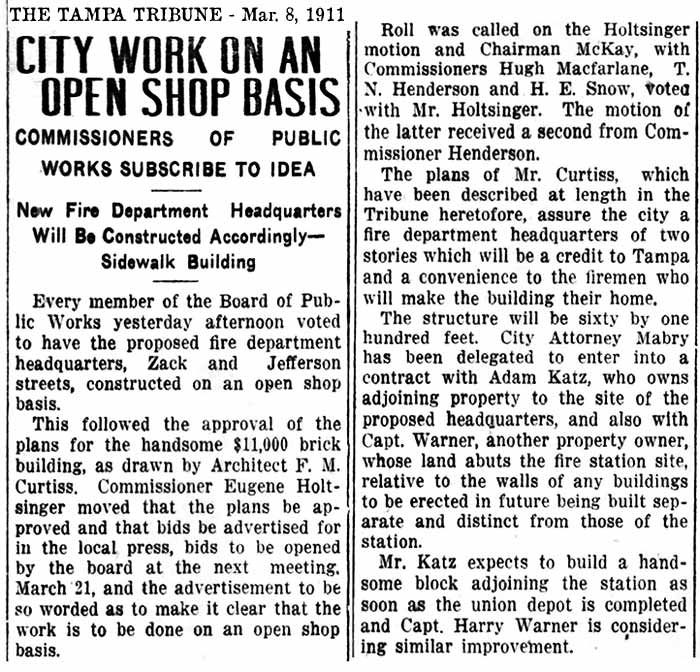
|
|
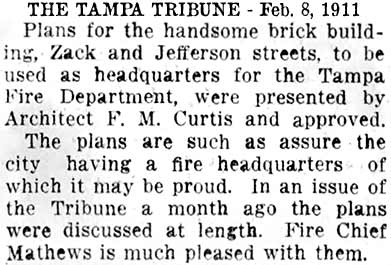
AT
RIGHT:
The
building
construction
was to
cost
$11,000
and the
ad for
bidding
to begin
was to
clearly
state
that the
construction
was on
an "Open
shop
basis."
City
Attorney
Giddings
Mabry
was to
enter
contracts
with
adjacent
property
owners
regarding
walls of
any
future
buildings
to have
separate
and
distinct
walls
from the
station.
An open
shop
construction
policy,
also
known as
a merit
shop, is
a
workplace
that
allows
incoming
recruits
and
existing
employees
to elect
whether
to join
a union,
rather
than
making
it a
requirement
for
employment,
as with
a closed
shop. |
THE WANING MONTHS OF
MAYOR D. B. McKAY'S FIRST YEAR
In Apr,
1911 Mayor McKay's
the first year of
his two year term in office
was coming to a
close, and still the
bond issue had not
yet been put to a
vote. Tampans were getting fed up with the politics of Tampa's city government. The promise to get the new City Hall built had been used so often in campaigns that one Tampan was ready to start tossing rotten eggs at the next politician who made the promise. The Tribune reader below described the stench and overcrowding which continued to plague old City Hall.
(One of the east
facade portals was a
stable for two
horses.)
"With a bulldog
sometimes
occupying a seat
of honor close
to the judge and
a dense crowd of
ignorant and
curious whites
and negroes
stampeding each
other to look
over the
shoulders of
those in front
of them for a
glimpse of the
unfortunate
prisoner, and
with no chairs
provided for any
but the court,
the picture of a
busy morning at
municipal court
is a ludicrous
and grotesque
one, and any
Tampan who seeks
inspiration for
a masterpiece
along that line,
in either art or
fiction, should
not fail to pay
a visit."
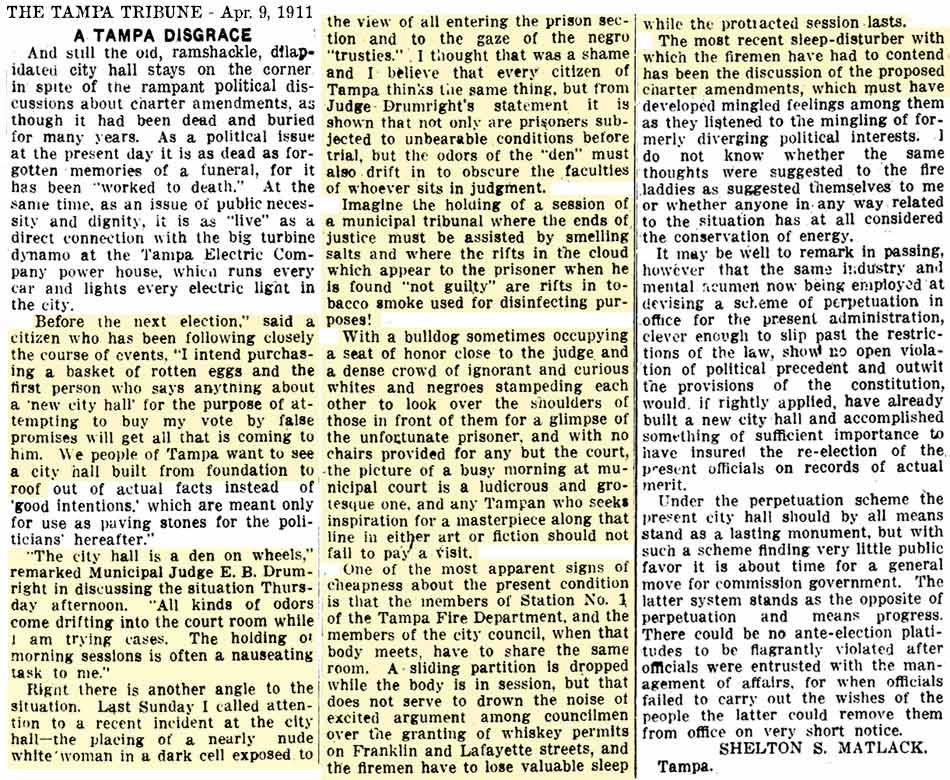
|
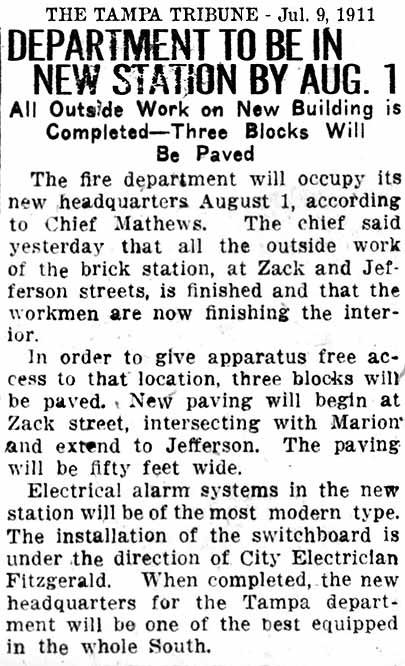
|
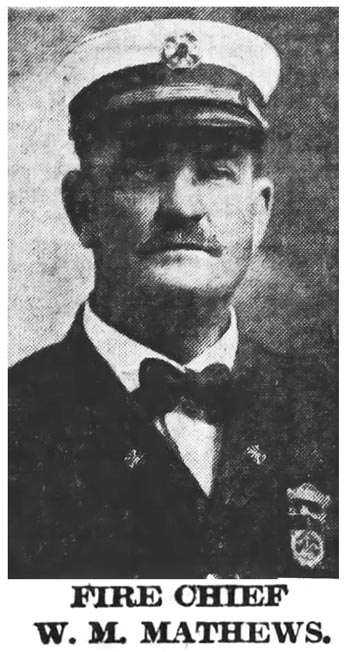 THE NEW FIRE DEPT. HEADQUARTERS IS READY THE NEW FIRE DEPT. HEADQUARTERS IS READYAT LEFT: The outside brick work of the building was finished and the interior was expected to be finished by end of month. The streets around the new station were being paved so the fire vehicles would have better access.
BELOW: In early August 1911 the fire department began moving from their headquarters at City Hall to the new station. The move was expected to cost $500. Plans were being made to modify City Hall so that the vacated space could be used by the police department. |
|
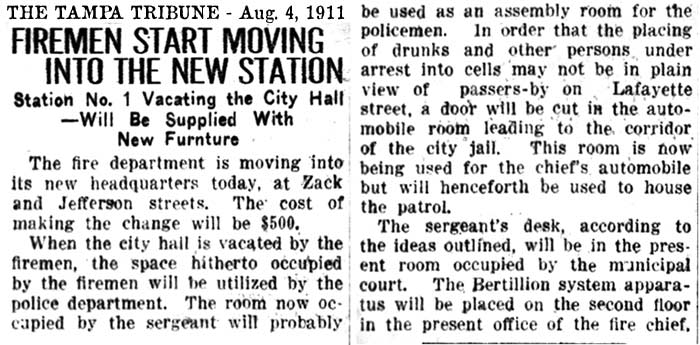
|
The Bertillon system is described later below.
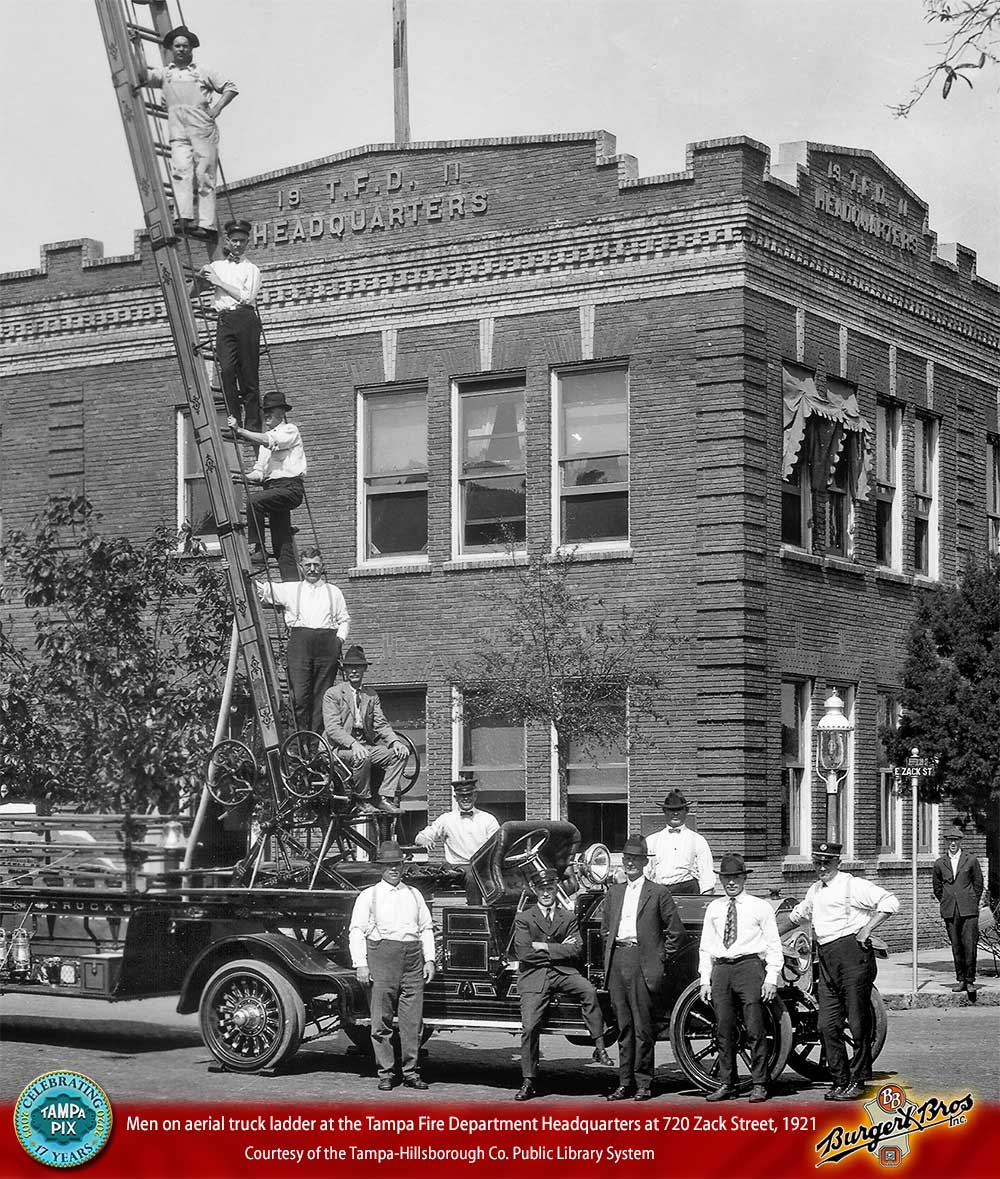
See the whole uncropped image larger.
When it opens, click it again to see full size.
|
|
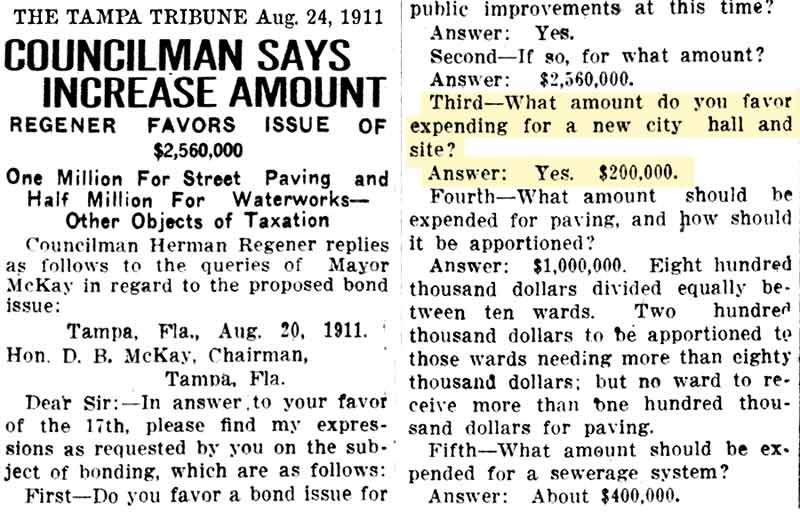
City Councilman
Herman Regener
favored a bond issue
of $2.56M with $200k
to go towards a new
City Hall.
CHARLES
BROWN
SUGGESTS
A PLAN TO
COST
PEANUTS
BY
COMPARISON,
SAYS FIX
OLD CITY
HALL FOR
NOW
There
was talk
of
building
a nice
brand
new
bridge
at Cass
Street
first,
so that
vehicles
and foot
traffic
didn't
have to
go all
the way
up to
Fortune
Street
to cross
the
river
when it
came
time to
remove
the
current
Lafayette
St.
bridge.
At this
time,
there
was only
a
railroad
bridge
at Cass
St.
Charles
Brown, President
of the
Tampa &
Gulf
Coast
Railroad,
well
known
Tampan
and
"director
in a
score of
businesses"
suggested
the City
build a
pontoon
(floating)
pedestrian
bridge
near to
Lafayette
St., as
temporary
one while a
new
Lafayette
St.
bridge
was
being
built,
rather
than
building
a
permanent
one at
Cass St.
to
redirect
traffic.
He said
vehicles
can put
up with
using
the
Fortune
St.
Bridge
for a
while.
He
suggested
that
City
Hall
be
repaired
for
$500--brick
masons,
a little
plaster,
some
touch-up
paint
and that
should
hold it
for a
few
years.
"You will understand that I am not a necessarily stingy man, but I don't care to have an awful big plate and nothing to eat out of it."
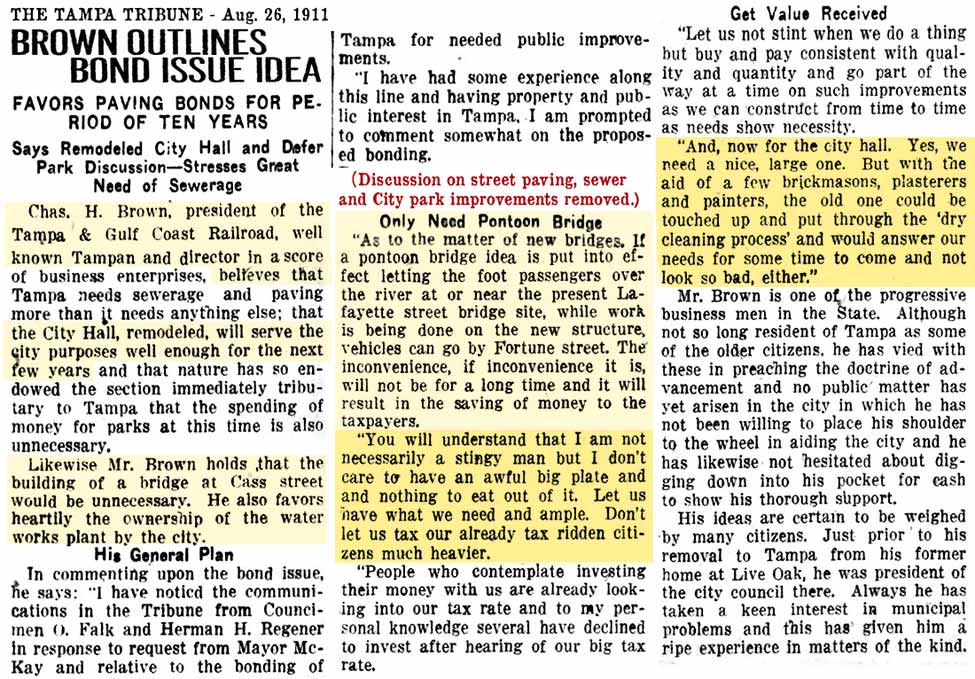
Brown
would
become
Mayor-Commissioner of
Tampa
ten years
later on
Jan. 4,
1921.
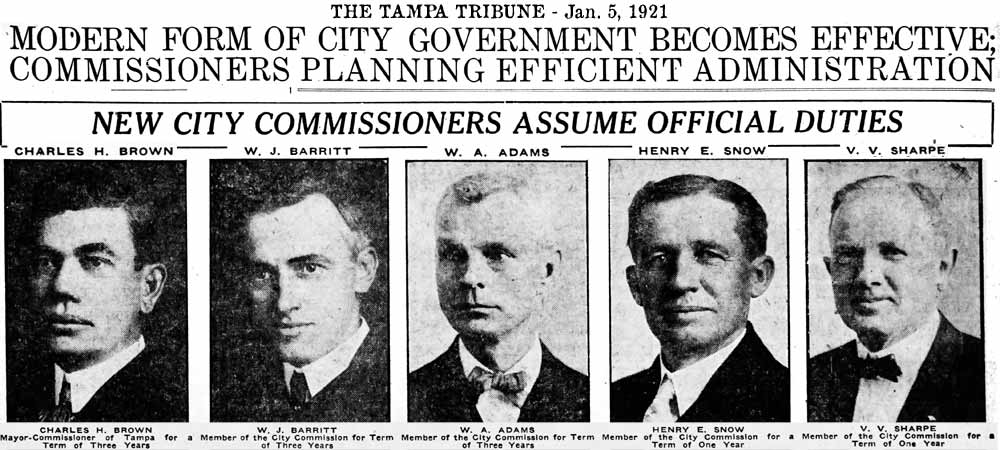
BOARD OF
PUBLIC
WORKS
LIKES BROWN'S
IDEA,
ALLOTS
$500
BUDGET TO
REPAIR
CITY
HALL
The
Board of
Public
Works
came up
with a
budget
for the
current
fiscal
year and
decided
not to
build
any new
buildings.
Instead,
they
decided
to
repair
old City
Hall
with
$500
which
was part
of the
"maintenance
of
public
buildings"
budget
of
$7,000.
The
previous
day, it
was
ordered
to begin
advertising
the
taking
of bids
for City
Hall
alterations
based on
Bonfoey
&
Elliott's
plan. Plans
were
also
accepted
and
estimates
submitted
for new
Lafayette
St.
bridge.
On Sep.
9 it was
published
that
some
items on
the
Board's
budget
had been
reduced.
For
maintenance
on
public
buildings,
from $7k
to $5k
but
still
only
$500 for
alterations
to City
Hall.
Repair
and
maintenance
on the
Fortune
St.
bridge
was
reduced from
$12k to
$10k.
The idea
was to
spend
less and
build a
new
stone
(cement)
bridge
for $50k
later.
(This
wasn't
accomplished
until
1927.
See the
Fortune
Street
bridge
history
here at
TampaPix.)
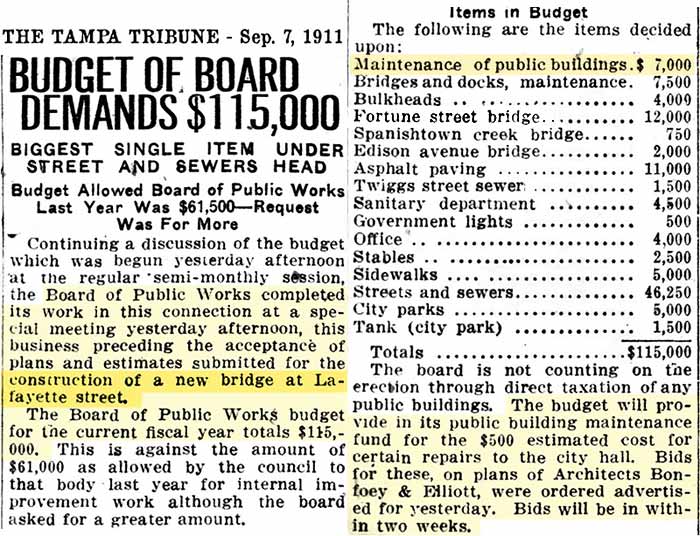
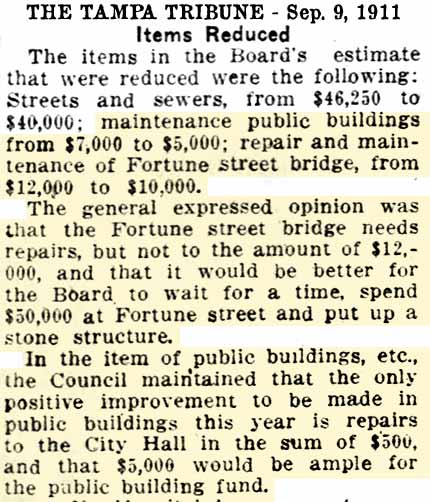
TRIBUNE
PRAISES
THE CITY
ADMINISTRATION
FOR
EFFICIENCY
AND
FUTURE
SEPARATE
BOND
ISSUES
The Tribune
was
pleased
that
every
department
of the
City
would be
well
taken
care of
and was
still
thrifty
without
impairing
public
service.
The most
important
part of
the plan
was the
building
of a new
Lafayette
St.
bridge
for
which a
separate
bond
issue of
$190k
had
already
been
passed,
approved,
bids
received
and
opened.
The lack
of any
funds
going
toward a
bridge
at Cass
St.
didn't
seem to
bother
the Tribune,
as it
considered
the
successful
completion
of a new
bridge
at
Lafayette
St. to
be
enough
success
for this
administration
to be
known as
the most
efficient
Tampa
has ever
known.

BIDDING
BEGINS
FOR OLD
CITY
HALL
REPAIRS
CONTRACTOR
Bonfoey
&
Elliott
was
chosen
to
design
the
improvements
for City
Hall.
Bidding
for the
job of
making
the
repairs
began on
Sep. 12,
1911.
On Sep.
20th, it
was
announced
that
only two
contractors
bid and
both
were
over
budget.
Another
round of
bidding
was
opened,
and this
time the
bids had
to be
accompanied
by a
$100
certified
check.
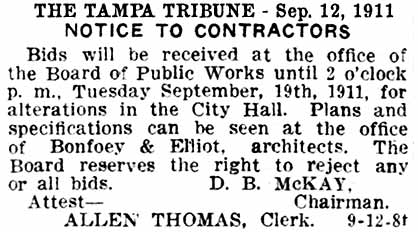
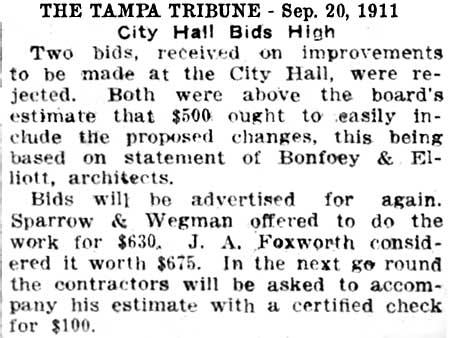
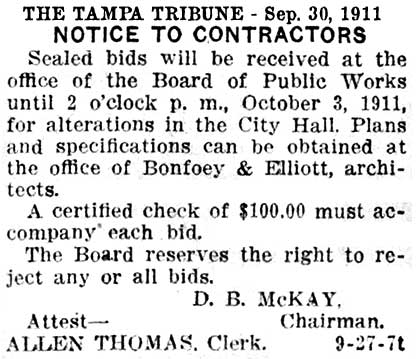
|
REMODELING OLD CITY HALL The contract to make alterations to City Hall was awarded to McNeil & Webb. The fire department space, having been vacated, would be converted into a large Police court room twice the size of the current one. An office and store room was being constructed for the City Electrician. The "police automobile" would use the same compartment used by the fire chief's car, and an entrance would be made on the Florida Ave. side through the building to the back so prisoners could be taken into jail without "the distasteful sight of running them in from Lafayette St. through the main entrance." The desk sergeant's room would be converted into a reception room. Remaining space would be made into dorms for police sleeping quarters. No mention is made of City Council or the Mayor so it appears that they would continue to pay rent in various buildings around the city. The second floor was to have a room for installing the Bertillon system. |
|
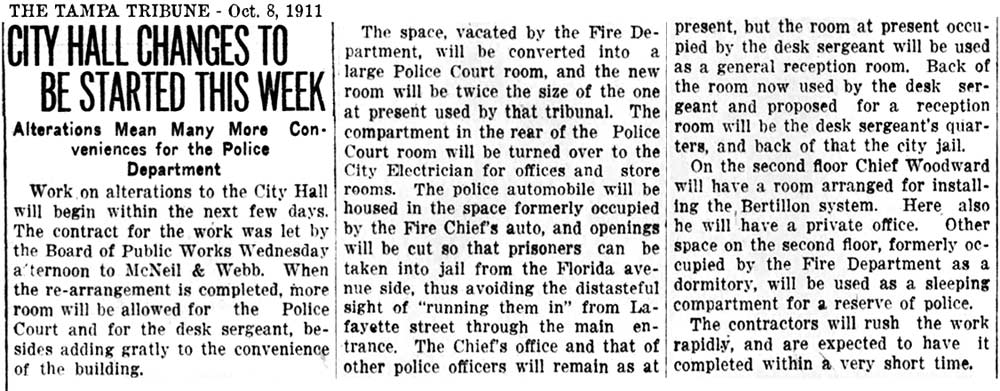
Nothing
more
about
these
alterations
could be
found in
the
papers
in the
next 6
months;
certainly
enough
time to
complete
$490
worth of
work
which
was
expected
to take
a "very
short
time."
The
signage
on old
City
Hall
would
probably
have
been
changed
at this
time to
reflect
the
location
of the
Police
Headquarters.
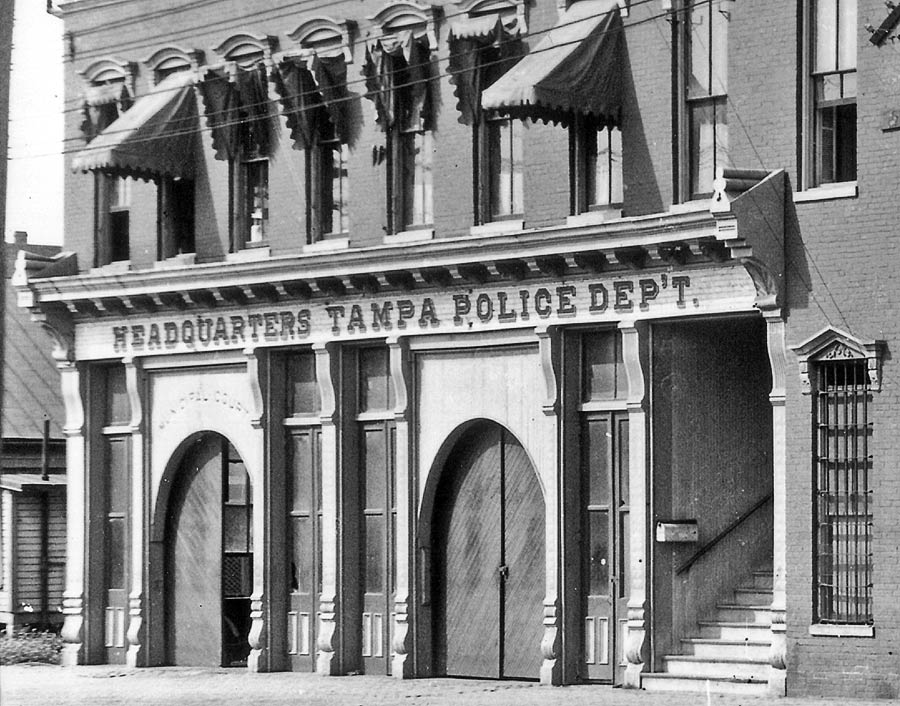
|

|
|
The Bertillon System, invented by French criminologist Alphonse Bertillon in 1879, was a technique for describing individuals on the basis of a catalogue of physical measurements, including standing height, sitting height (length of trunk and head), distance between fingertips with arms outstretched, and size of head, right ear, left foot, digits, and forearm. In addition, distinctive personal features, such as eye color, scars, and deformities, were noted. The system was used to identify criminals in the later years of the nineteenth century, but was soon displaced by the more reliable and easily-recorded fingerprints. |
|
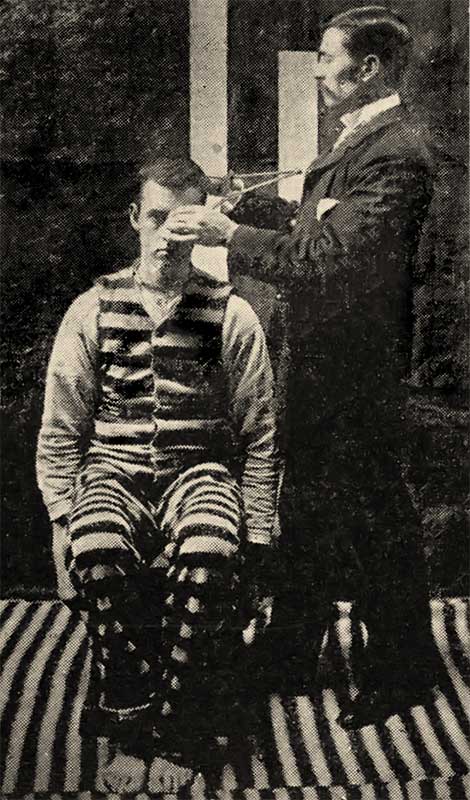
|
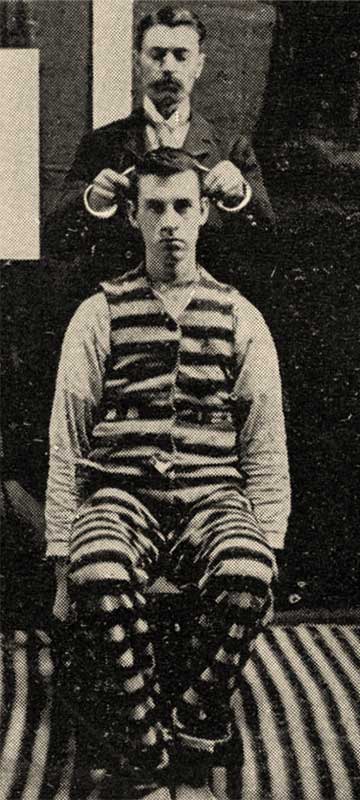
|
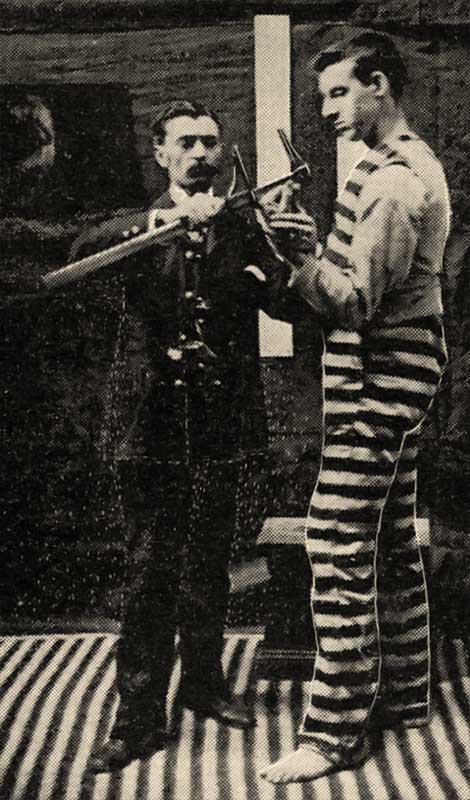
|
|

|
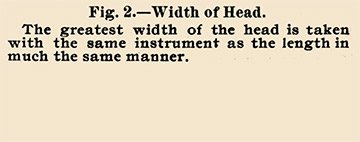
|
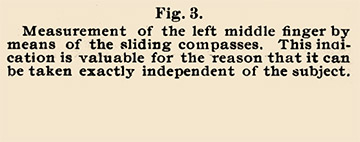 |
| |
|
|
|
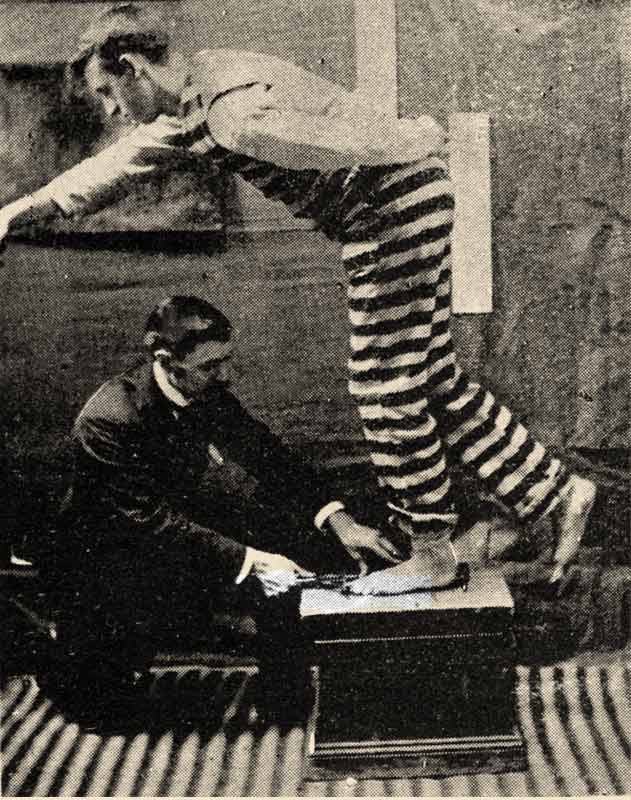
|

|
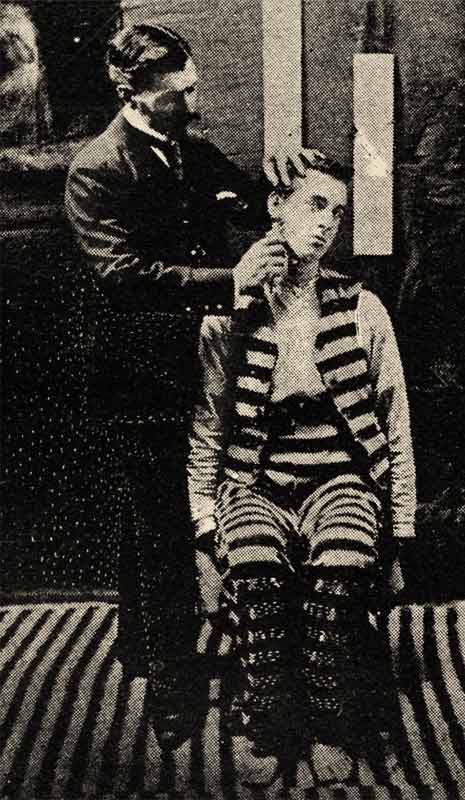
|
|
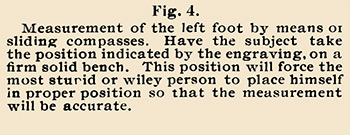
|
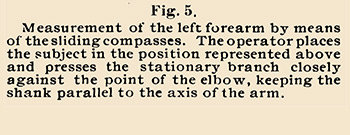
|
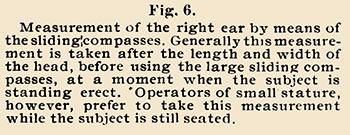
|
|
Images above courtesy of HISTORYAPOLIS: The Bertillon System: Science and Crime in the Global Information Age |
|
THE BERTILLON FILING SYSTEM
The photos and measurements are virtually useless without a filing and retrieval system that could facilitate the location of cards of suspects with common characteristics. Today, computers do it in a split second. Alphonse Bertillon's filing system depended on a complicated method that cross-referenced a standardized set of identifying characteristics, making the information retrievable. From a mass of details, recorded on hundreds of thousands of cards, it was possible to sift and sort down the cards until a small stack of cards produced the combined facts of the measurements of the individual sought. The cards were arranged to make efficient use of space. The identification process was entirely independent of names and the final identification was confirmed by the photographs included on the individual's card. Although it was somewhat difficult to use, modernizers in many countries took it as a model system for tracking and controlling individual citizens and immigrants.
Bertillon also devised a method to document and study a victim's body and circumstances of death. Using a camera on a high tripod, lens facing the ground, a police photographer made top-down views of the crime scene to record all the details in the immediate vicinity of a victim's body. Early in the 20th century, police departments began to use Bertillon's method to photograph murder scenes.
Information above photo below from the National Library of Medicine: Visible Proofs: Forensic Views of the Body
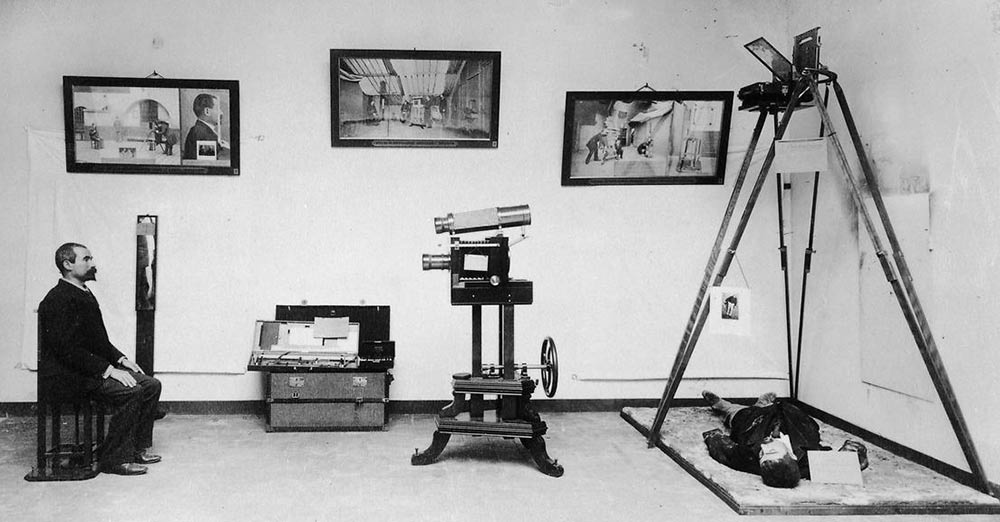
|
|
1913 Burgert Bros. photo below courtesy of
the University of South Fla. Digital
Collections
An elevated view of Franklin Street looking
north.
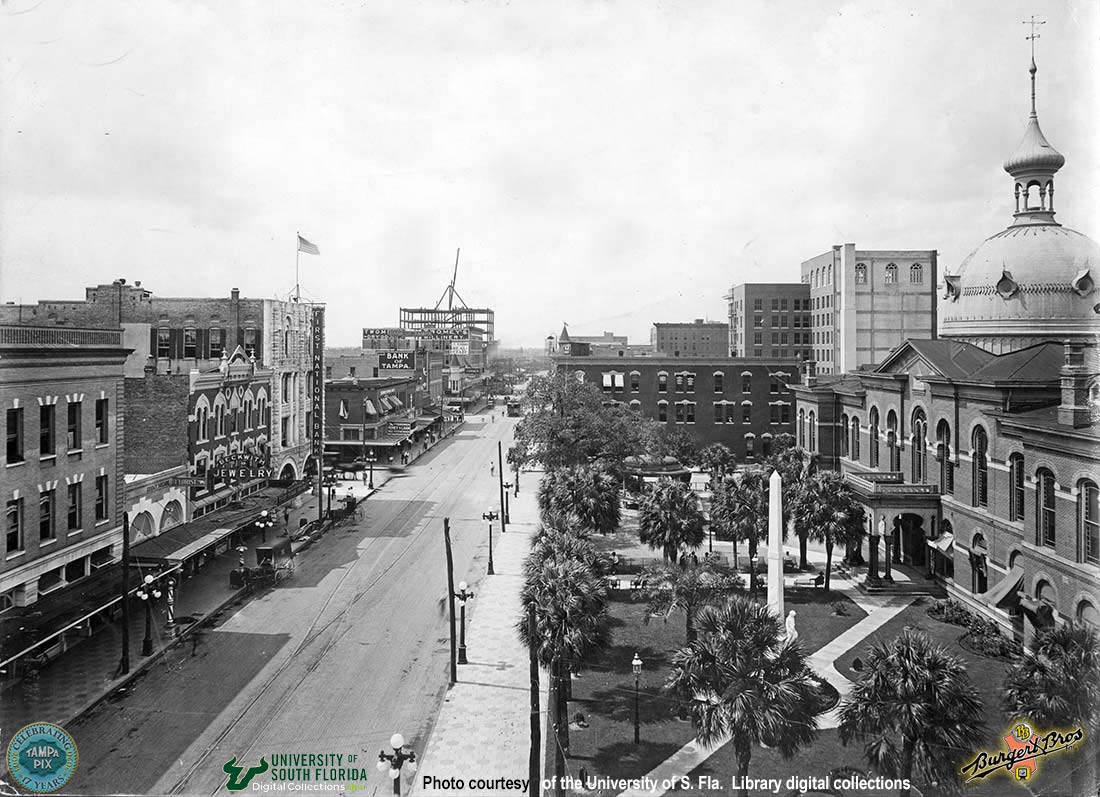
In 1911,
where
would
you want
to put a
town
clock,
disgraceful
City
Hall, or
here?
NEXT PAGE:
Chapter
II:
1911 to
1912,
Hortense
Oppenheimer
& Ye
Towne
Cryers
Breakout
pages -
"Subfeatures"
(These
pages
are in
various
stages
of
completion)
"MEET
THE
FRECKERS
and THE
EMBEZZLEMENT
TRIAL OF
CHARLIE
FRECKER"
WHO WAS E. M.
GREESON AND WHAT
HAPPENED TO HIS
THEATER?
THE
OPPENHEIMERS
OF TAMPA
WHO
REALLY
WAS
WALLACE
F. JAKA?
1913
SOUTHWARD
VIEW
FROM
ROOF OF
BAY VIEW
HOTEL
|
|
|
|
|
|
| |